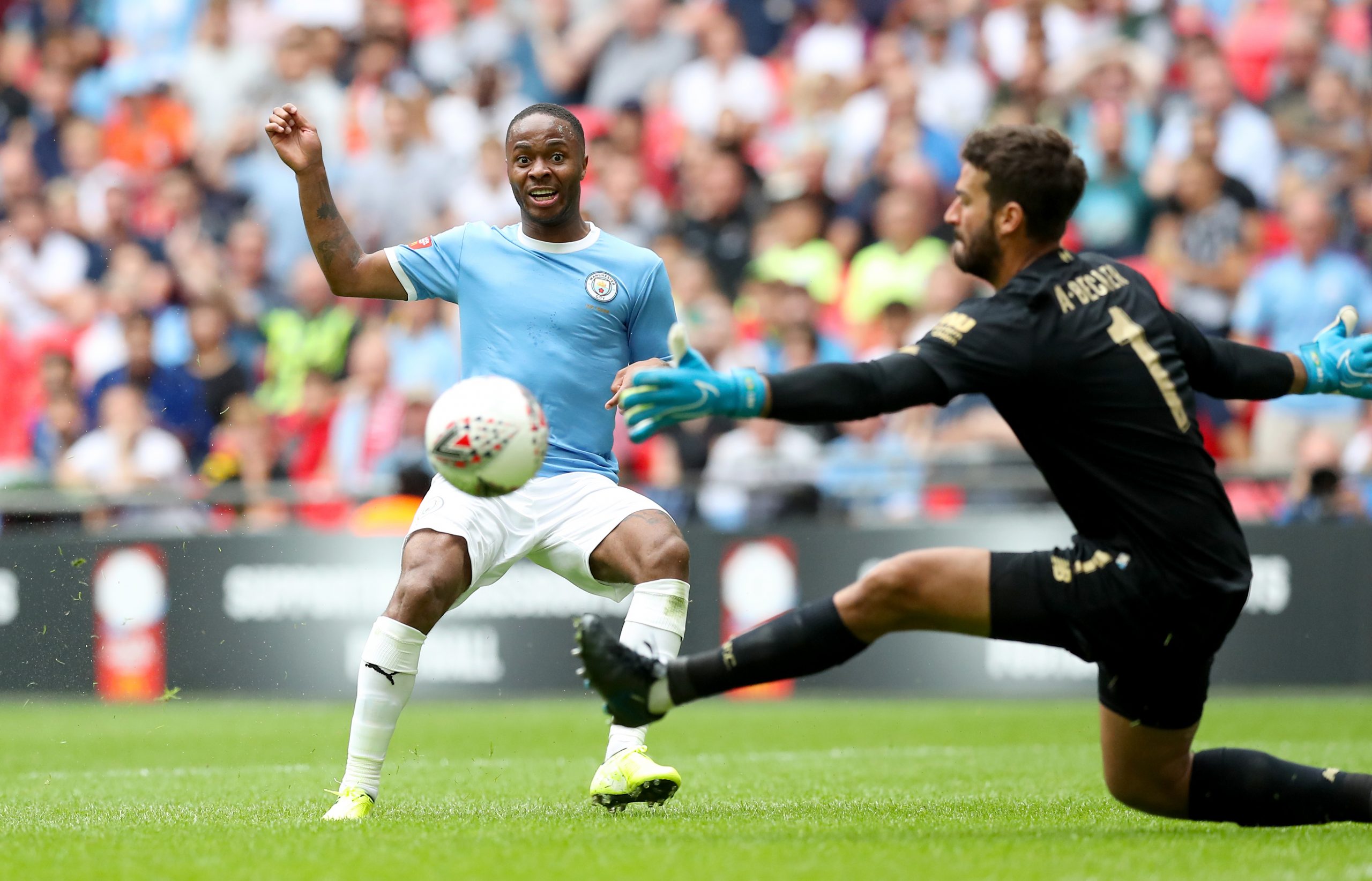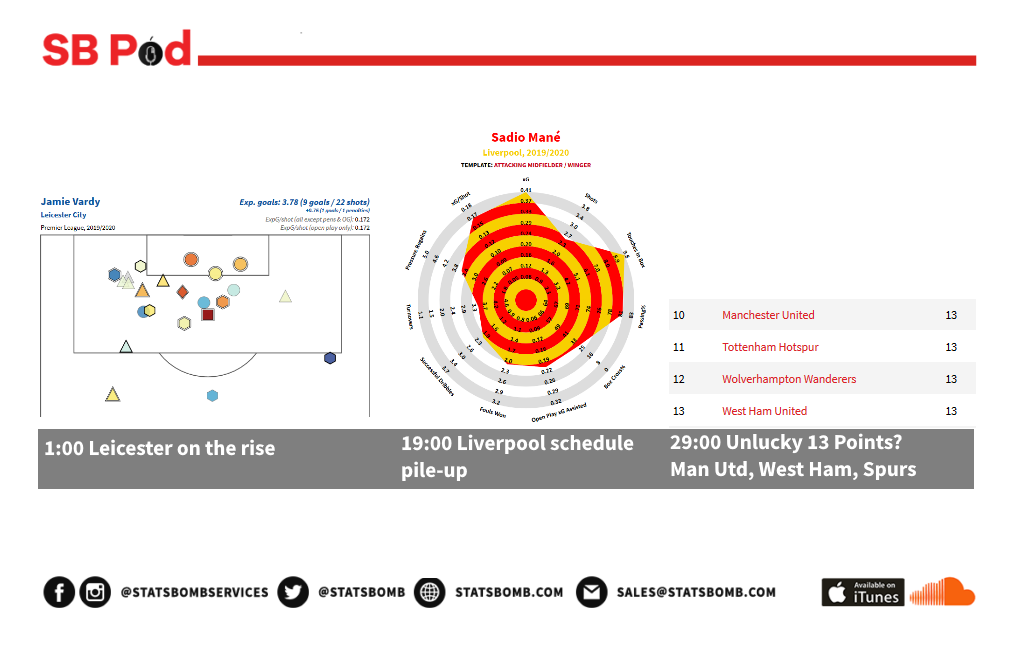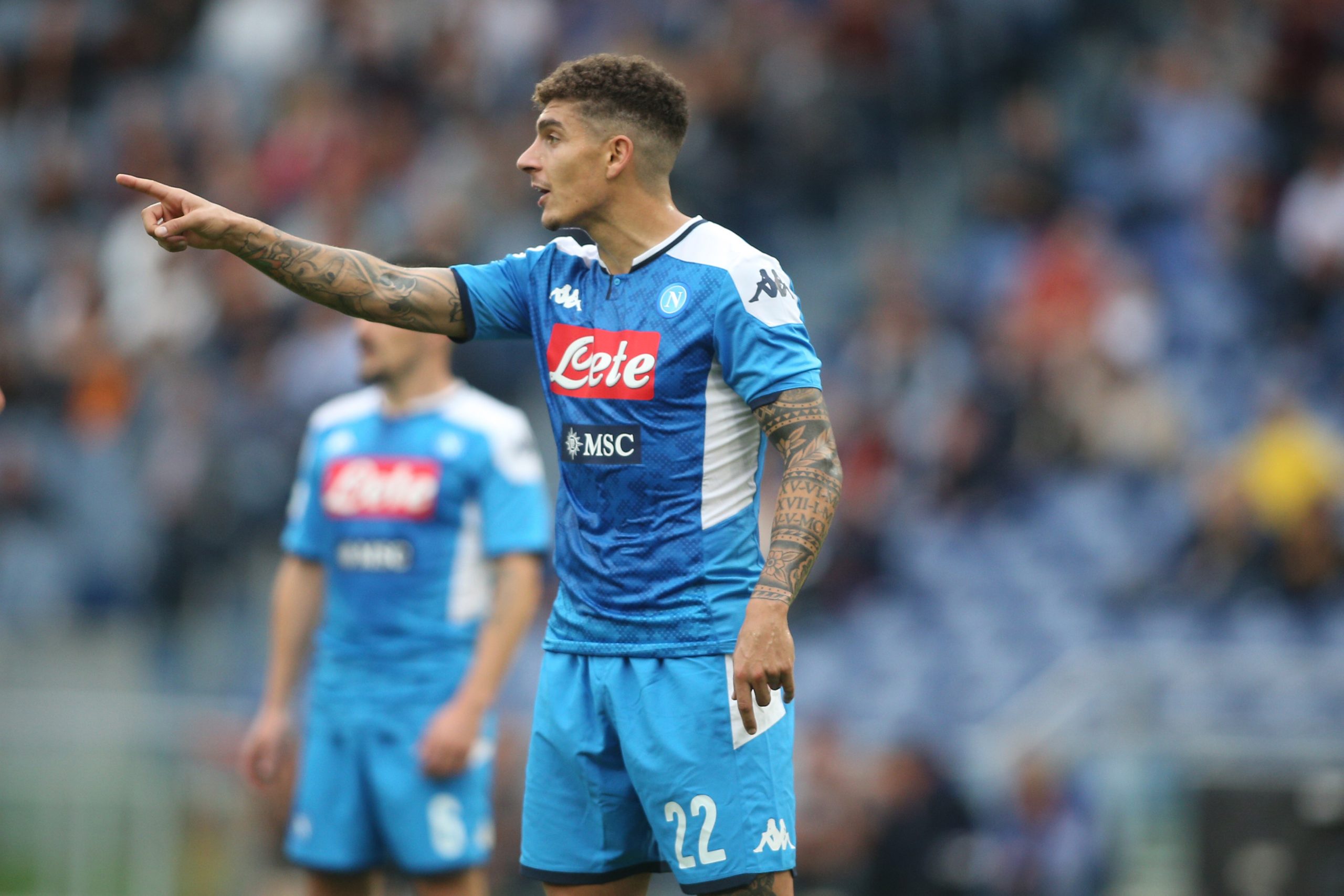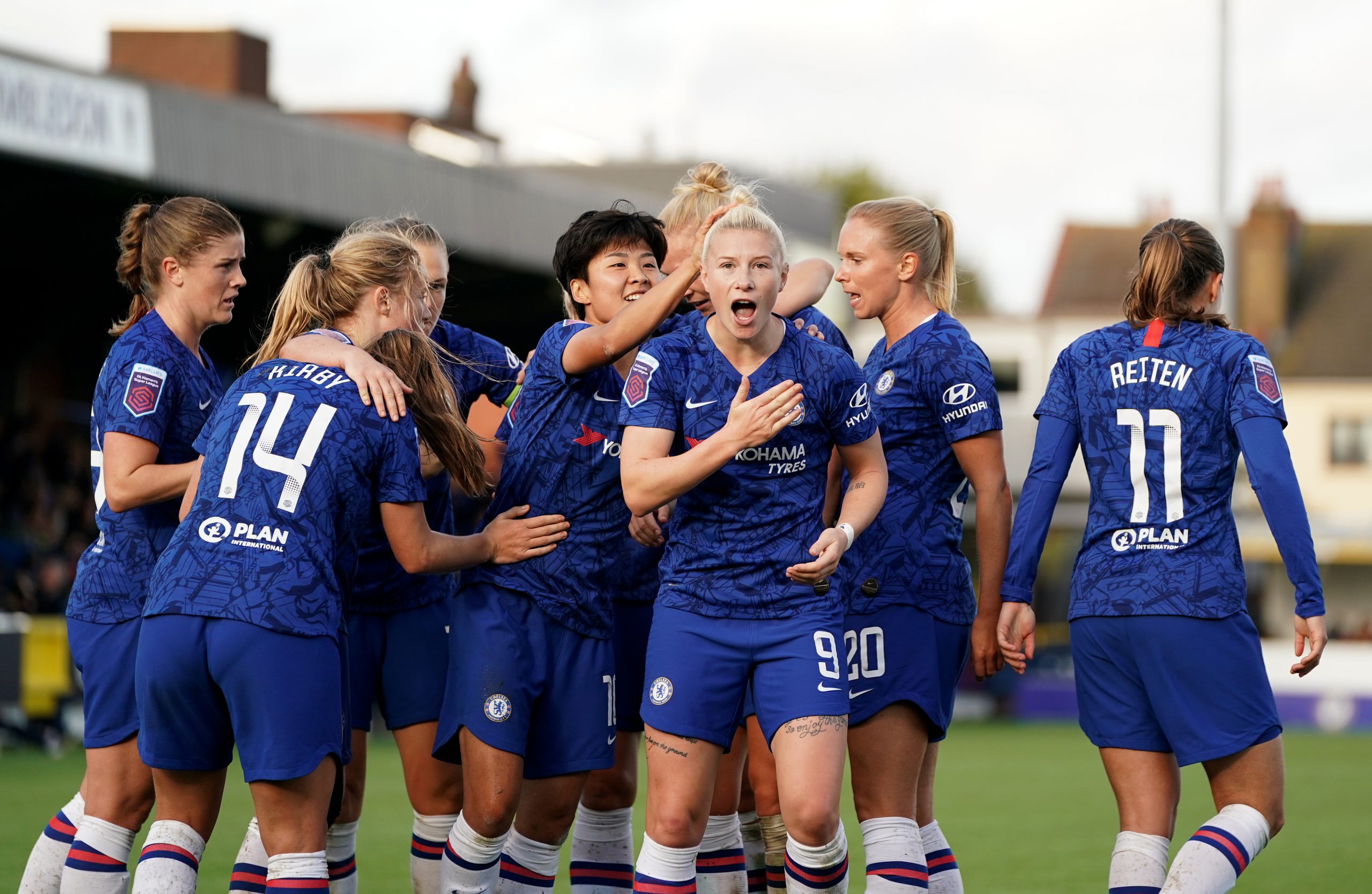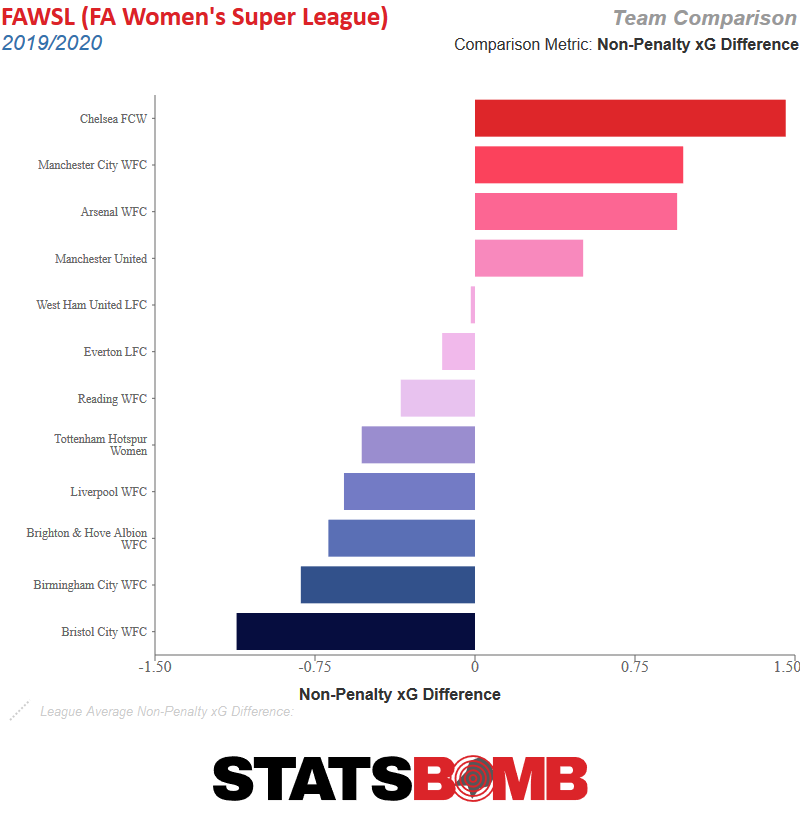It’s the first top of the table clash of the season and, to the surprise of many, the reigning champions are behind. The results shaking out the way they have mean that Jürgen Klopp’s Liverpool enter the fixture six points ahead of Pep Guardiola’s Manchester City. Such is the strength of City that the bookmakers generally give Liverpool an implied probability of only 54-58% to win the title, with City expected to at least close the gap over the rest of the season. This is what makes this Sunday such a knife edge: a nine point deficit could easily be too much to bridge. So how did we get here? Well, perhaps not as one might assume. In terms of expected goals, City are still crushing the league. On the attacking side, they’re generating 60% more expected goals than Liverpool while only looking slightly worse on the defensive end. In xG difference, it’s Guardiola’s Premier League and we’re just living in it. 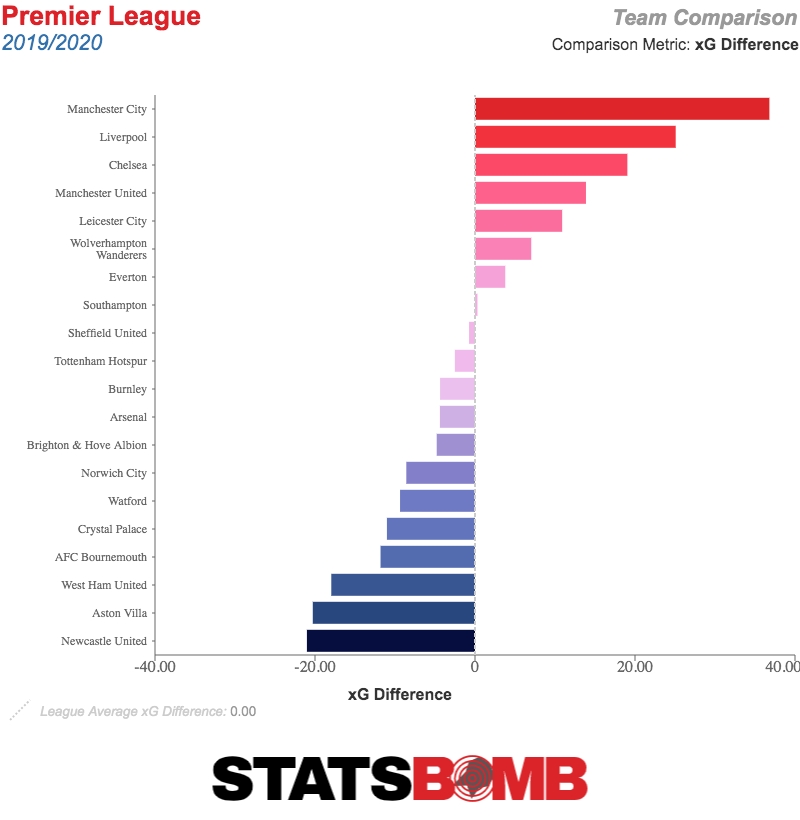 That shouldn’t imply that there are not real reasons why City have had a few wobbles, though. The defensive team radar comparing this season to last about sums up their struggles on that side of the ball: City are now a higher pressing side than ever, but at the same time are conceding chances of better quality than ever before, and have paid the price more than once.
That shouldn’t imply that there are not real reasons why City have had a few wobbles, though. The defensive team radar comparing this season to last about sums up their struggles on that side of the ball: City are now a higher pressing side than ever, but at the same time are conceding chances of better quality than ever before, and have paid the price more than once. 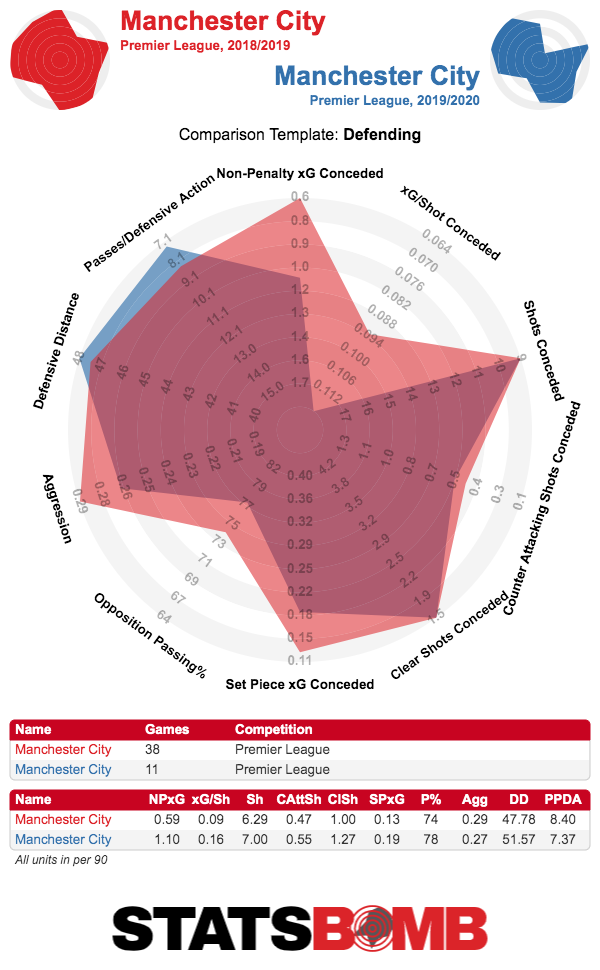 City’s central problem is that they’ve struggled to “cheat” the problems of a high press and prevent getting cut open in occasional moments when something goes wrong. I wrote about this in greater depth a month ago, but since then, Guardiola has tweaked things in hope of stopping the leak. The 4-4-2/4-2-3-1 shape he was experimenting with seems to have been shelved for now in favour of the tried and trusted 4-3-3, but this time with İlkay Gündoğan at the base of the midfield rather than Rodri (who now appears to be an option, at least in desperate times, at centre back). City have played three Premier League games since this switch, which is far too small a sample size to make huge conclusions, but the early evidence is good, even if they’re overperforming xG by quite a bit.
City’s central problem is that they’ve struggled to “cheat” the problems of a high press and prevent getting cut open in occasional moments when something goes wrong. I wrote about this in greater depth a month ago, but since then, Guardiola has tweaked things in hope of stopping the leak. The 4-4-2/4-2-3-1 shape he was experimenting with seems to have been shelved for now in favour of the tried and trusted 4-3-3, but this time with İlkay Gündoğan at the base of the midfield rather than Rodri (who now appears to be an option, at least in desperate times, at centre back). City have played three Premier League games since this switch, which is far too small a sample size to make huge conclusions, but the early evidence is good, even if they’re overperforming xG by quite a bit. 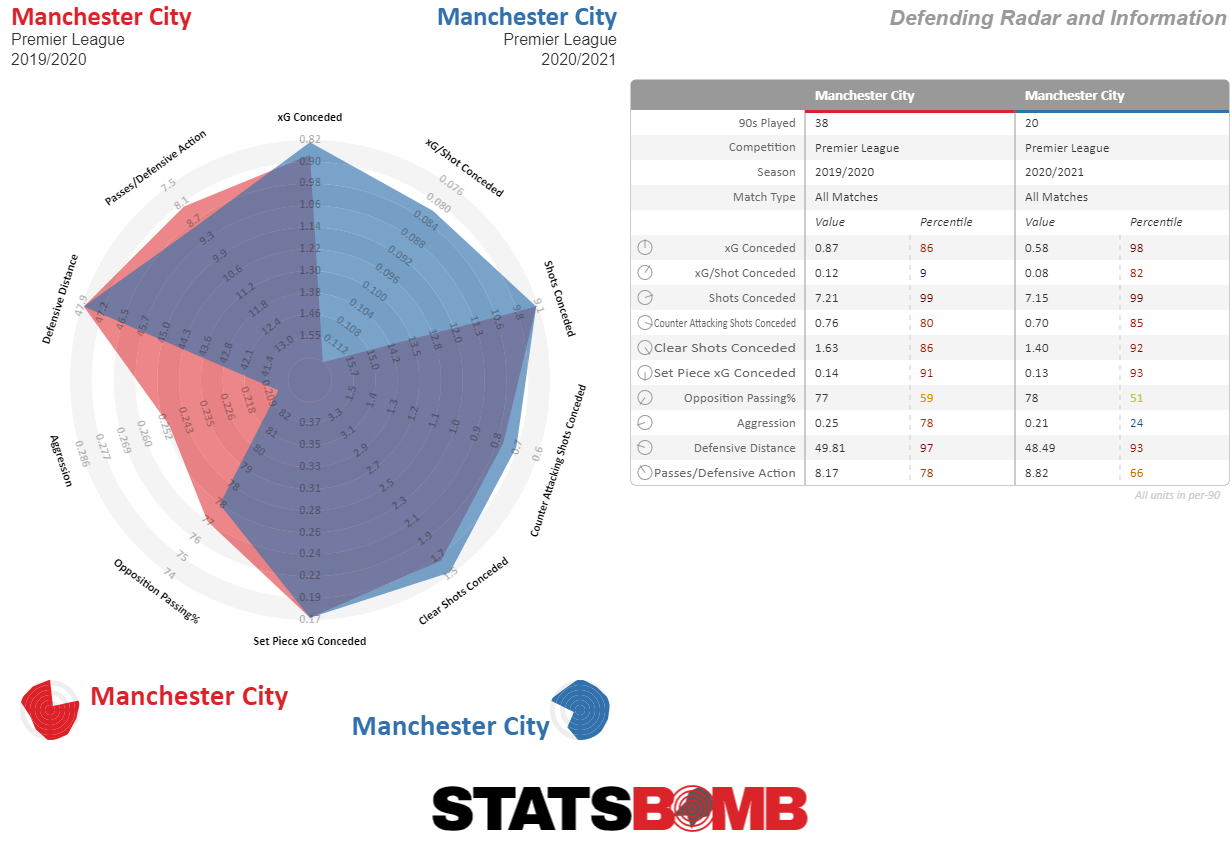 In this very small sample, the shots conceded per game has stayed consistent with what came before at seven, but the xG per shot conceded has fallen from 0.17 to a more manageable 0.13. To be very clear, we’re only talking a couple of shots being placed slightly differently here, so we shouldn't get ahead of ourselves, but it’s more the sort of stability that City had in the previous two seasons. If Gundogan is really to be the main defensive midfielder in this side rather than Rodri, then questions open up about his suitability in filling the role formerly held by Fernandinho. The Brazilian is often talked about for his genuine ability at tactical fouling, making around 1.6 fouls per 90 last season, but Gundogan has not generally managed anything like that rate in his career, failing to hit more than 1 per 90 in any of the seasons for which StatsBomb has collected data. He’s never been able to put in as many tackles and interceptions at the rate of Fernandinho. And for a role that in this particular system requires range and mobility, Gundogan’s injury record raises real concerns.
In this very small sample, the shots conceded per game has stayed consistent with what came before at seven, but the xG per shot conceded has fallen from 0.17 to a more manageable 0.13. To be very clear, we’re only talking a couple of shots being placed slightly differently here, so we shouldn't get ahead of ourselves, but it’s more the sort of stability that City had in the previous two seasons. If Gundogan is really to be the main defensive midfielder in this side rather than Rodri, then questions open up about his suitability in filling the role formerly held by Fernandinho. The Brazilian is often talked about for his genuine ability at tactical fouling, making around 1.6 fouls per 90 last season, but Gundogan has not generally managed anything like that rate in his career, failing to hit more than 1 per 90 in any of the seasons for which StatsBomb has collected data. He’s never been able to put in as many tackles and interceptions at the rate of Fernandinho. And for a role that in this particular system requires range and mobility, Gundogan’s injury record raises real concerns.  On the other side, the results just keep coming for Liverpool. An xG conceded per game of 0.96 is better than City’s, and only Leicester are outdoing it in the Premier League this season, but it’s still worse than last year’s 0.75. There’s better news beyond the xG. Liverpool are conceding fewer deep completions and fewer opposition passes inside the box than ever before. The passes inside the box tally is less than half the next best Premier League side or even the Liverpool of last season. It might just be that opposing attackers have been particularly adept at turning dangerous situations into shots. Liverpool might be as good as ever defensively, but it’s hard to say either way for sure.
On the other side, the results just keep coming for Liverpool. An xG conceded per game of 0.96 is better than City’s, and only Leicester are outdoing it in the Premier League this season, but it’s still worse than last year’s 0.75. There’s better news beyond the xG. Liverpool are conceding fewer deep completions and fewer opposition passes inside the box than ever before. The passes inside the box tally is less than half the next best Premier League side or even the Liverpool of last season. It might just be that opposing attackers have been particularly adept at turning dangerous situations into shots. Liverpool might be as good as ever defensively, but it’s hard to say either way for sure. 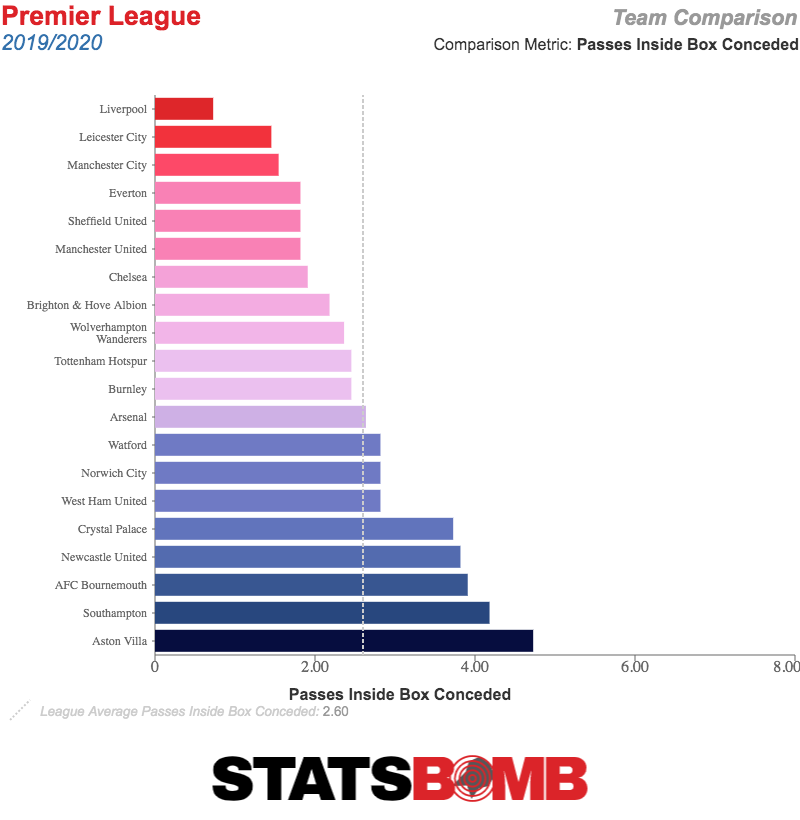 On the attacking side, Liverpool’s output looks largely consistent with last year, and it’s the way they do it that has drawn the most attention. The way Klopp instructs his side to attack is to move the ball from the fullbacks into the front three, ignoring almost any notion of creative passing through midfield. In terms of progressing the ball into the final third, the two fullbacks, Trent Alexander-Arnold and Andrew Robertson, lead the way along with Fabinho. When it comes to open passes into the box, it’s the fullbacks again with Sadio Mane. The two number eights, Gini Wijnaldum and Jordan Henderson, just don’t play important parts in moving the ball forward for Liverpool. Alexander-Arnold in particular is really becoming the side’s most important playmaker, putting up a monster 0.36 xG assisted per 90 (albeit including set pieces). Liverpool are able to play this way because their fullbacks are so useful in possession, and the defensive end stays solid because the midfielders are given so little freedom. The template for Liverpool vs Manchester City games has been well established at this point. City play their usual intricate football of working the ball through the midfield, into the “free eights” and to the wide players to attempt create their exquisite chances, while Liverpool engage in a counter-press, attempt to win the ball and attack when City are in a poor shape counterattack down the half spaces. It’s a tactical rhythm that feels predictable now, and if the game pans out this way, both sides should have a fair few chances with the magic of finishing to perhaps be the deciding factor. There are two games between the sides in recent seasons that didn’t fall into that pattern, however. The first was City’s 5-0 drubbing of Liverpool at the Etihad in September 2017. The most important moment of that match was Mane’s first half sending off, which forced Liverpool to retreat and largely just defend their own goal, which they did poorly. Barring any unexpected reckless challenges, it doesn’t seem like that game is hugely relevant to this one. The other fixture, though, was last season’s October 0-0 draw at Anfield. This one was very unusual in that Guardiola seemed content with taking a point. The two sides combined for all of 12 non-penalty shots, none of them particularly good chances, and every neutral went home disappointed. It might be that the Catalan feels six points is too big a gap to take a draw, but this scenario is entirely on the table and could lead to another underwhelming encounter. The case for City settling for the point, for trusting that they can bridge the six point gap over the season, is in the numbers. City have been playing better football than Liverpool first and foremost, yes, but they’ve also been playing more attacking football. A more expansive game should, in theory, be the more effective way of picking up a huge points total when facing teams of lower ability than themselves. Liverpool’s much less expansive approach relies on keeping it tighter and wearing down the opposition as things go on, with lower scoring fixtures. City’s approach should be capable of overpowering just about everyone. Even in situations where they concede, it’s a question of how many goals you need to score to get a point against City. The case that they need the win here is in the fixture list. Liverpool have already faced Chelsea, Tottenham, Manchester United and, if we’re expanding the scope of the elite club to seven, Leicester. This game will complete the set of fixtures against the “big teams” for Klopp’s side in the first half of the season. City, by comparison, have only faced Tottenham of this group so far. The fixture list gets real across November and December, and City will need to be near perfect in these games if Liverpool do not provide serious slip ups. It’s well within their capability to do so (especially taking into account that performances so far this season raise serious questions about just how elite various members of the elite group of seven are), but Guardiola wouldn’t be making life easy for himself if he didn’t close the gap to three points on Sunday. If Liverpool were to win, a gap of nine points would certainly create a different dynamic. Klopp’s team could conceivably ease off a touch and still have a very good chance of winning the title. City could play their best football and still fail to lift the trophy in May. It is for that reason that playing it safe is on the cards for Guardiola. Header image courtesy of the Press Association
On the attacking side, Liverpool’s output looks largely consistent with last year, and it’s the way they do it that has drawn the most attention. The way Klopp instructs his side to attack is to move the ball from the fullbacks into the front three, ignoring almost any notion of creative passing through midfield. In terms of progressing the ball into the final third, the two fullbacks, Trent Alexander-Arnold and Andrew Robertson, lead the way along with Fabinho. When it comes to open passes into the box, it’s the fullbacks again with Sadio Mane. The two number eights, Gini Wijnaldum and Jordan Henderson, just don’t play important parts in moving the ball forward for Liverpool. Alexander-Arnold in particular is really becoming the side’s most important playmaker, putting up a monster 0.36 xG assisted per 90 (albeit including set pieces). Liverpool are able to play this way because their fullbacks are so useful in possession, and the defensive end stays solid because the midfielders are given so little freedom. The template for Liverpool vs Manchester City games has been well established at this point. City play their usual intricate football of working the ball through the midfield, into the “free eights” and to the wide players to attempt create their exquisite chances, while Liverpool engage in a counter-press, attempt to win the ball and attack when City are in a poor shape counterattack down the half spaces. It’s a tactical rhythm that feels predictable now, and if the game pans out this way, both sides should have a fair few chances with the magic of finishing to perhaps be the deciding factor. There are two games between the sides in recent seasons that didn’t fall into that pattern, however. The first was City’s 5-0 drubbing of Liverpool at the Etihad in September 2017. The most important moment of that match was Mane’s first half sending off, which forced Liverpool to retreat and largely just defend their own goal, which they did poorly. Barring any unexpected reckless challenges, it doesn’t seem like that game is hugely relevant to this one. The other fixture, though, was last season’s October 0-0 draw at Anfield. This one was very unusual in that Guardiola seemed content with taking a point. The two sides combined for all of 12 non-penalty shots, none of them particularly good chances, and every neutral went home disappointed. It might be that the Catalan feels six points is too big a gap to take a draw, but this scenario is entirely on the table and could lead to another underwhelming encounter. The case for City settling for the point, for trusting that they can bridge the six point gap over the season, is in the numbers. City have been playing better football than Liverpool first and foremost, yes, but they’ve also been playing more attacking football. A more expansive game should, in theory, be the more effective way of picking up a huge points total when facing teams of lower ability than themselves. Liverpool’s much less expansive approach relies on keeping it tighter and wearing down the opposition as things go on, with lower scoring fixtures. City’s approach should be capable of overpowering just about everyone. Even in situations where they concede, it’s a question of how many goals you need to score to get a point against City. The case that they need the win here is in the fixture list. Liverpool have already faced Chelsea, Tottenham, Manchester United and, if we’re expanding the scope of the elite club to seven, Leicester. This game will complete the set of fixtures against the “big teams” for Klopp’s side in the first half of the season. City, by comparison, have only faced Tottenham of this group so far. The fixture list gets real across November and December, and City will need to be near perfect in these games if Liverpool do not provide serious slip ups. It’s well within their capability to do so (especially taking into account that performances so far this season raise serious questions about just how elite various members of the elite group of seven are), but Guardiola wouldn’t be making life easy for himself if he didn’t close the gap to three points on Sunday. If Liverpool were to win, a gap of nine points would certainly create a different dynamic. Klopp’s team could conceivably ease off a touch and still have a very good chance of winning the title. City could play their best football and still fail to lift the trophy in May. It is for that reason that playing it safe is on the cards for Guardiola. Header image courtesy of the Press Association
Month: November 2019
StatsBomb Podcast: November 2019 #1, Rise of Leicester, Liverpool Schedule, Unlucky 13 Points?
Who are the best Premier League goal scorers you're not paying attention to?
The top of the Premier League’s individual expected goals per 90 table is full of all the usual suspects. Exactly half of the top ten (among players with at least 600 minutes on the pitch) are players you’d guess on the first try. Sergio Aguero is still better at scoring goals than everybody. Everybody knows by now that Tammy Abraham is having a star making season. Raheem Sterling, Mohammed Salah, and Sadio Mané are all elite scorers from the wing. They’re all there. But, mixed in are another five players, players who might surprise and amaze you. These are their stories.
Danny Ings: The xG paper tiger
Every year Danny Ings spends part of the season popping up as a surprisingly formidable attacking player. And seemingly every year he squanders his chances, then gets hurt then everybody forgets about him until he starts the next year off in a similarly promising fashion. Ings is once again rocking the attacking production. He’s averaging 0.53 non-penalty xG per 90 minutes. That’s third in the league. He’s doing it by averaging a bunch of shots, 2.94, the ninth highest total in the league and making sure they’re good ones, among players who hit the minutes cutoff and take at least a shot per 90 his 0.18 xG is eight. Imagine Tammy Abraham, take away roughly one shot per match, and that’s what Danny Ings’s numbers look like. As per usual with Ings there’s the caveat that while he’s played the requisite number of minutes, he’s still been used intermittently and has seen less playing time than anybody else in the top ten. 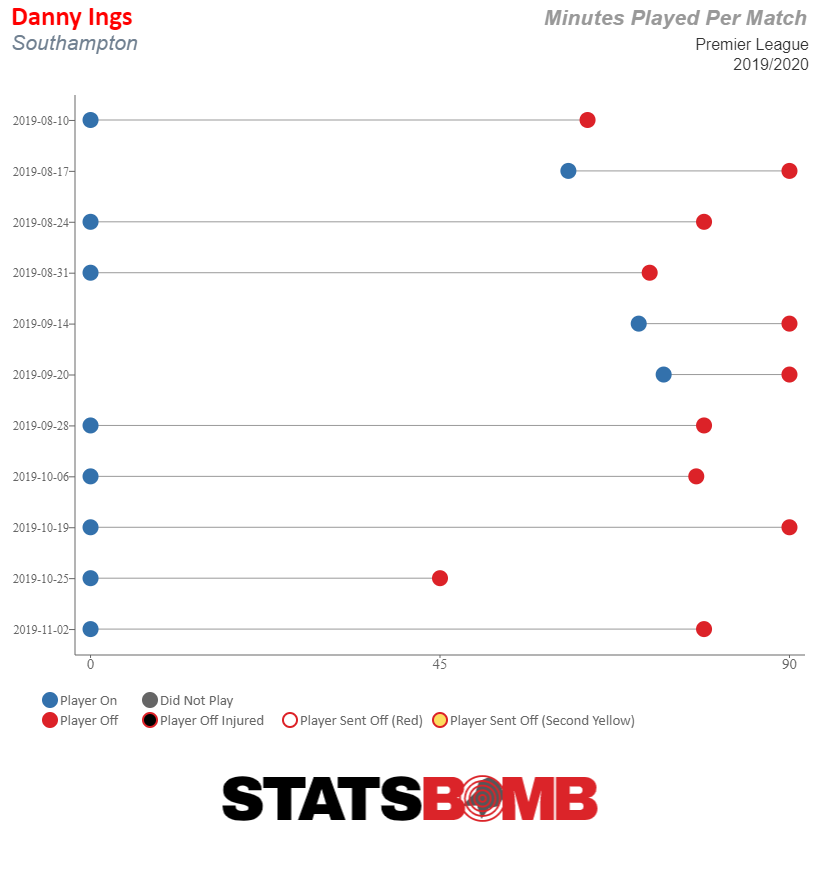 That means we’re only talking about a little over 4 xG and 23 total shots. Still, though, they’re really good shots.
That means we’re only talking about a little over 4 xG and 23 total shots. Still, though, they’re really good shots.
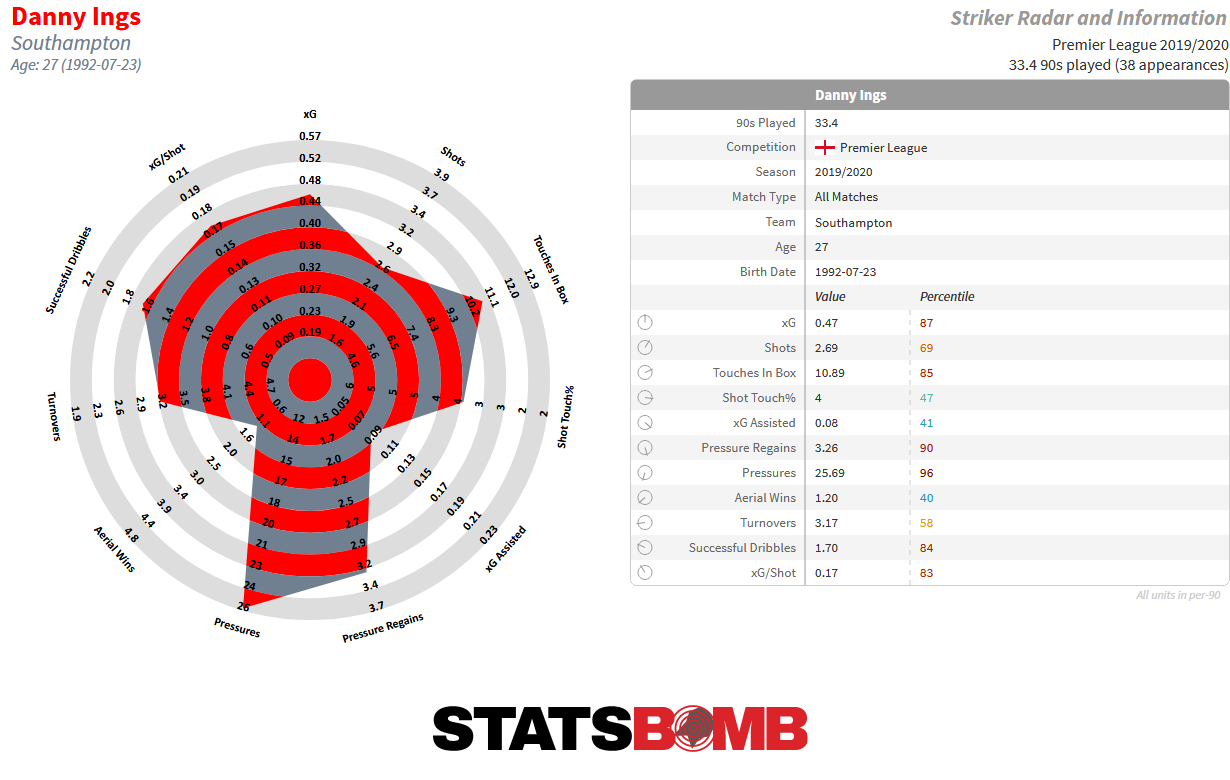 Chris Wood and Ashley Barnes: The dynamic duo
Chris Wood and Ashley Barnes: The dynamic duo
If you’re looking for pairs of elite scorers Manchester City has them all. Aguero and Sterling top the list. After them it’s Aguero and Bernardo Silva, followed by Aguero and David Silva. Then it’s Sterling and Silva, and Sterling and the other Silva. City have the top five pairs. Then, its Salah and Mané who combine for 0.91 xG per 90. But just behind those two. It’s who comes next that’s stunning. Burnley’s set of, apparently world beating strikers, Chris Wood and Ashley Barnes clock in at a combined 0.90 are barely outscored by Liverpool's wingers. The two of them are well matched. Wood shoots less frequently, only 2.00 times per match, the third least frequent shooter of any in the top 20 of xG per 90, but his 0.23 xG per shot is extraordinary. 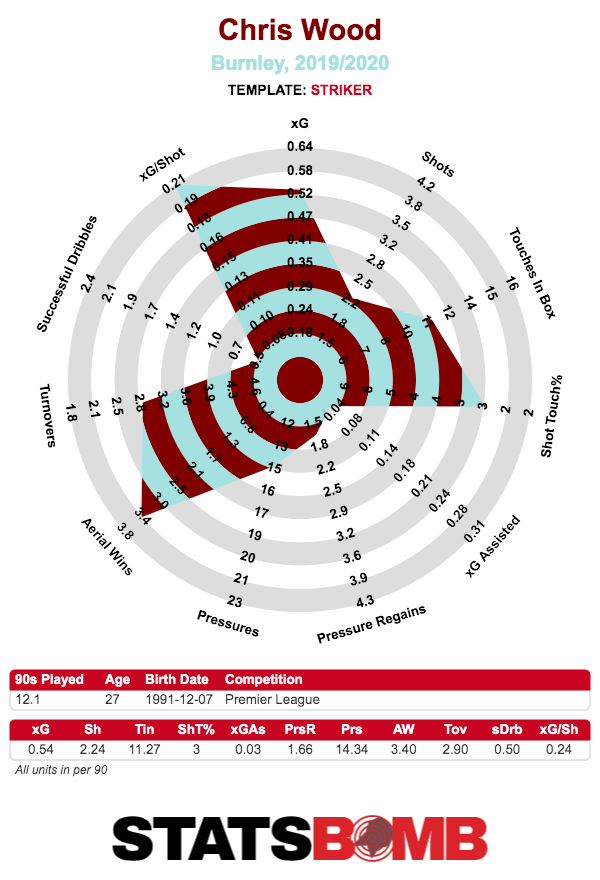 Barnes on the other hand both shoots more, and from somewhat more varied positions, with 3.23 shots per 90 and a still respectfully robust 0.14 xG per shot.
Barnes on the other hand both shoots more, and from somewhat more varied positions, with 3.23 shots per 90 and a still respectfully robust 0.14 xG per shot. 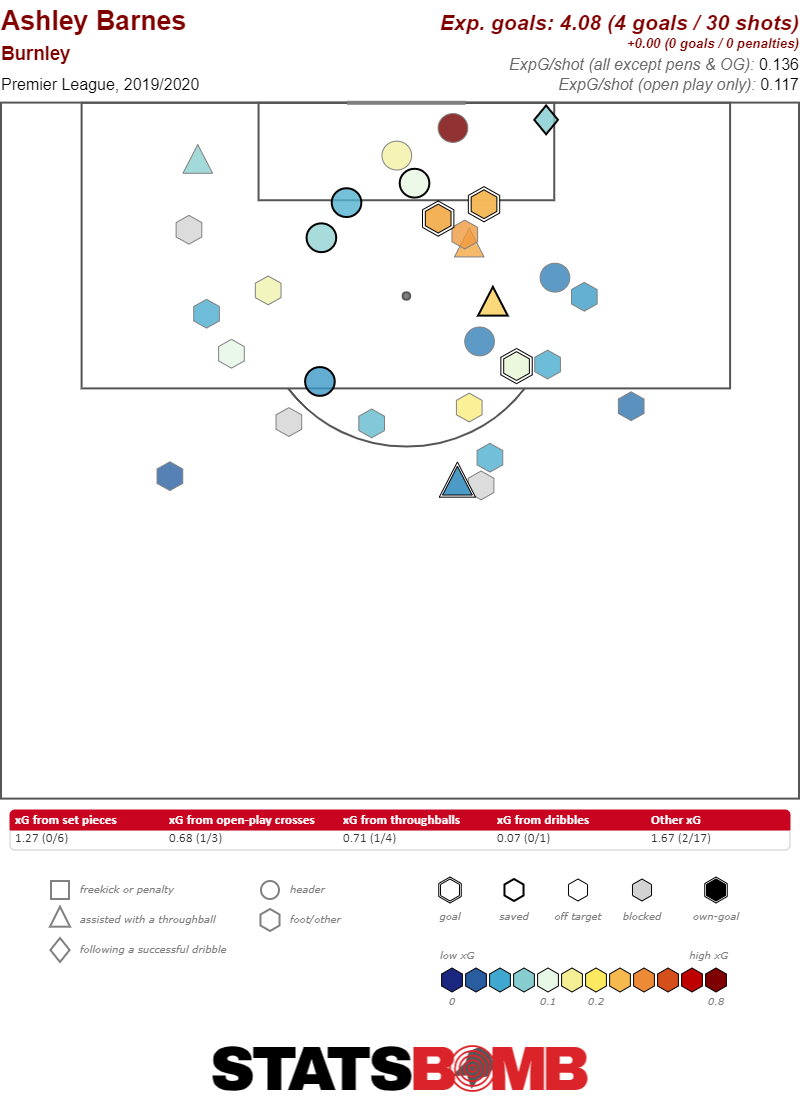 What really makes the Barnes and Wood show so incredible is that Burnley only averages 1.14 xG total per match. It’s really just the two of them holding down the attacking fort.
What really makes the Barnes and Wood show so incredible is that Burnley only averages 1.14 xG total per match. It’s really just the two of them holding down the attacking fort. 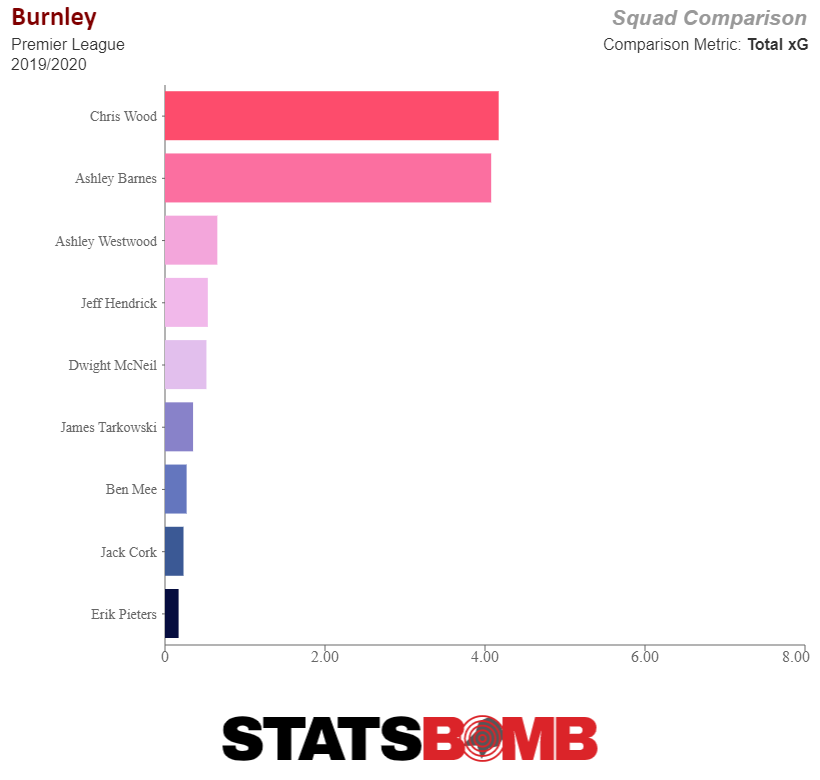 Obviously, City, who have four different players appearing in the top five two-man combinations, aren’t nearly as narrowly reliant, and neither are Liverpool. Here’s how their top two stack up with everybody else. Unsurprisingly Liverpool’s big three are in fact a big three and they have help from the fullbacks.
Obviously, City, who have four different players appearing in the top five two-man combinations, aren’t nearly as narrowly reliant, and neither are Liverpool. Here’s how their top two stack up with everybody else. Unsurprisingly Liverpool’s big three are in fact a big three and they have help from the fullbacks. 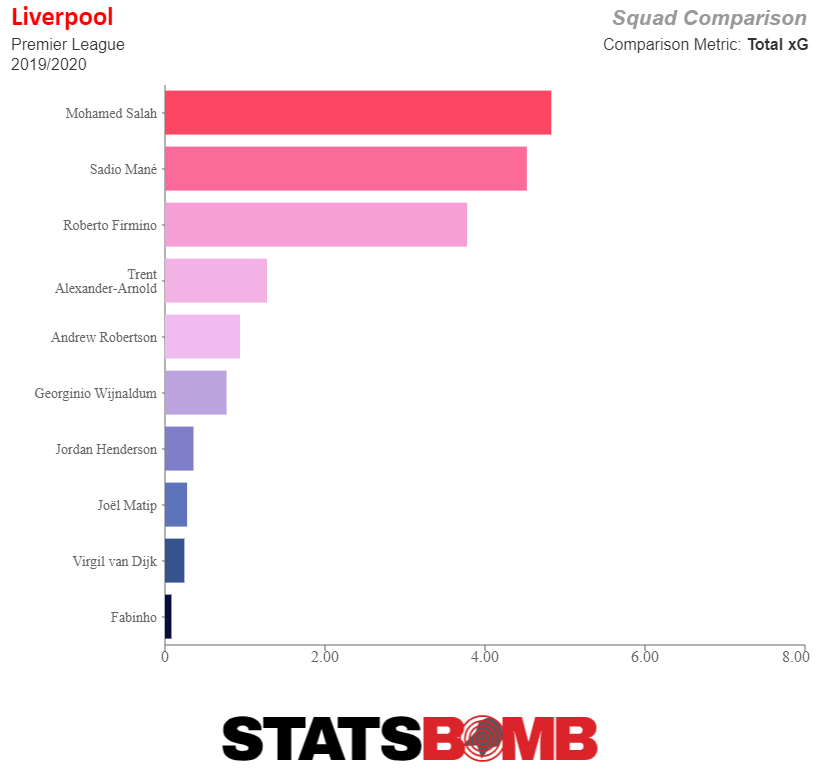 Burnley are a two-man attacking show, and so far this season those two men have been among the best in the league.
Burnley are a two-man attacking show, and so far this season those two men have been among the best in the league.
Neal Maupay: Making the leap at Brighton
It’s easy to miss just how strong Neal Maupay’s start to life at the Premier League level has been. Among the top twenty in xG per 90 only one other player is underperforming their xG total by as much as Maupay who is averaging 0.32 non-penalty goals per 90 against 0.46 xG (though what this means practically given the limited minutes is that he has three goals as opposed to 4.26 xG). He’s in good company though, since the other player significantly under their xG total is Salah. As Brighton’s featured attacker, Maupay shoot a lot, 3.45 times per 90 is fourth most frequent in the Premier League, and while his shot chart can get a little ugly, he keeps the xG per shot at 0.13 which is respectable enough (it is, again, right in line with Salah). 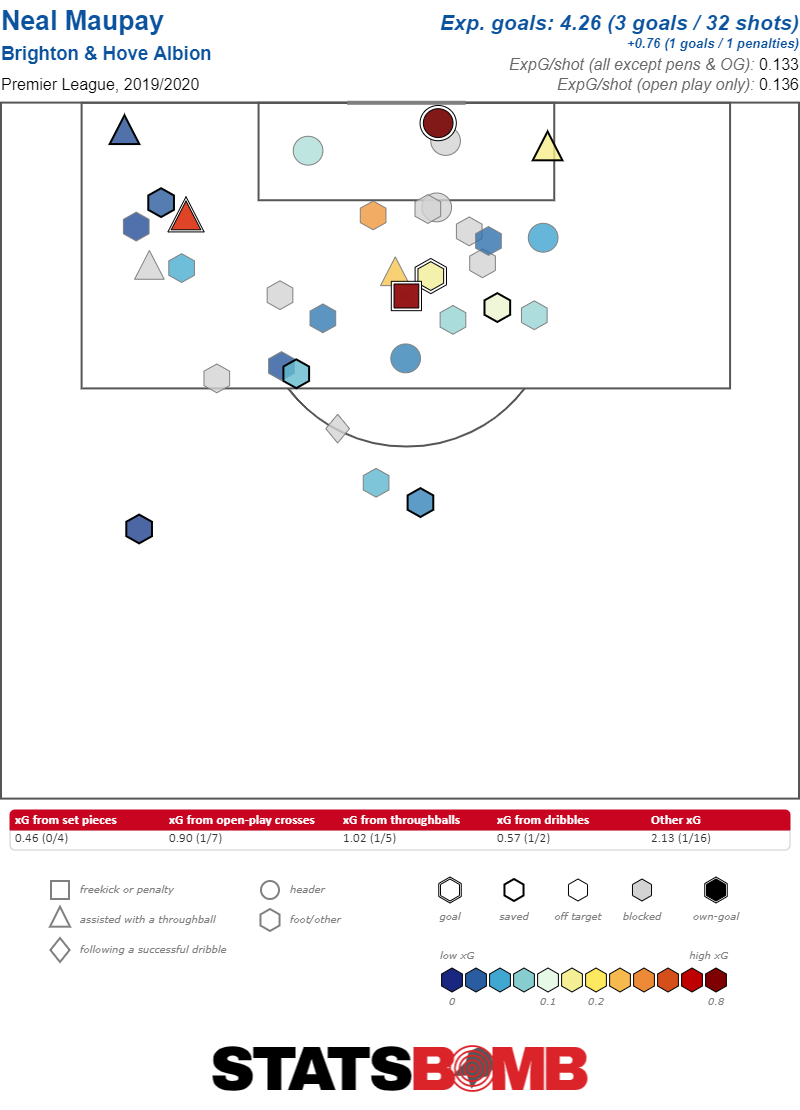 Notably Maupay isn’t just a goal scorer. He’s an acceptable passer, and a defensive contributor as well. It’s still early, of course, but so far he looks like one of the most successful and impactful new signings of the Premier League season.
Notably Maupay isn’t just a goal scorer. He’s an acceptable passer, and a defensive contributor as well. It’s still early, of course, but so far he looks like one of the most successful and impactful new signings of the Premier League season. 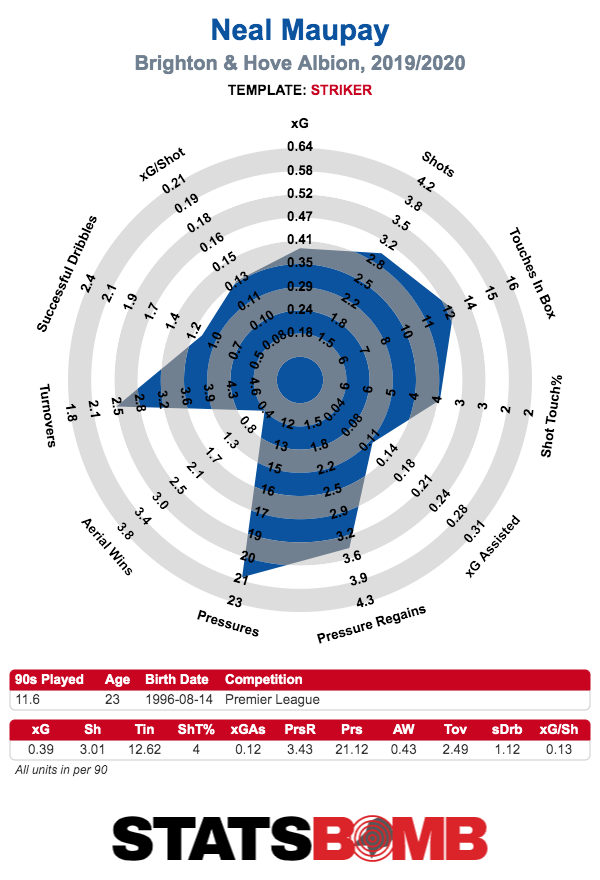
Callum Wilson: Bournemouth’s old reliable
And finally, there’s Callum Wilson. You don’t have to shoot much if when you do shoot, you shot from where Wilson shoots from. The man has five goals from 17 shots, and that’s exactly what xG would predict. Not too shabby. 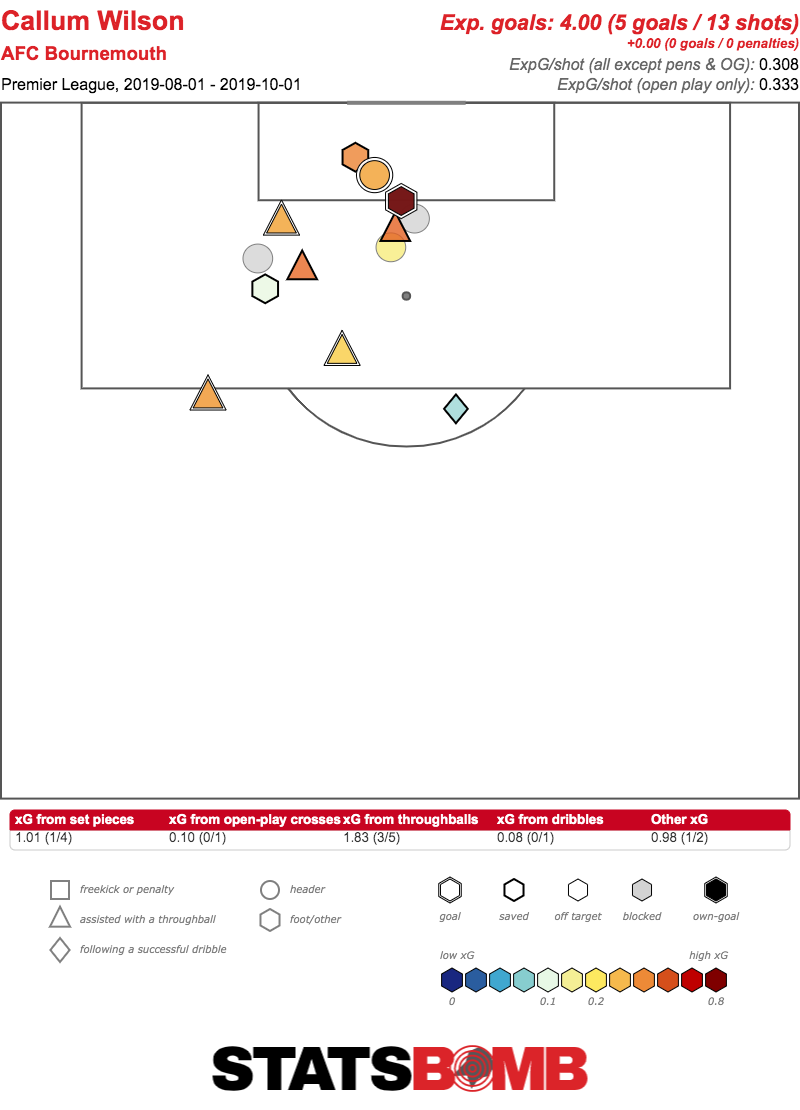
Is something wrong with Napoli?
Napoli and Atalanta are the only teams in Serie A's top six that have the same coach leading the team as last season. Considering that they kept their core practically intact, it was fair to expect that the Azzurri would start strong, while the other teams got used to new methods of work and different tactics.
And yet, after eleven games, Ancelotti's team has collected only 18 points out of a possible 33. They've lost to Juventus at the Allianz Stadium in an even contest and at home against Cagliari, and in Rome on Saturday against AS Roma. They have also drawn 3 disappointing matches against Torino, SPAL and Atalanta, games in which they were unable to turn their superiority into a win.
There's no obvious reason why the team hasn't been able to keep up with Juventus and Inter so far, who have already gained leads of 11 and 10 points respectively. However, the trend is worrying because in the first 19 games of the 2018/19 season, Napoli lost only 13 points of the total possible amount and conceded a total of 17 goals, while so far this season they have already dropped 15 points and have let the ball in 15 times in basically half of the games.
Defense
Usually elite teams concede roughly nine shots per game but for now, in Serie A, only Juventus concede less than 11 shots on average (they're best in the league with 10.82). Ancelotti's Napoli has never been exceptional in suppressing shots, but this year they've been worse than ever, conceding 13.00 shots per game (ninth in the league). A not so radical decline compared to last season when Napoli was third in the league with 11.50 shots conceded. However, Napoli tend to concede low-quality scoring chances: last season they topped the league both in non-penalty expected goals conceded (0.81 per game) and in xG per shot (0.071).
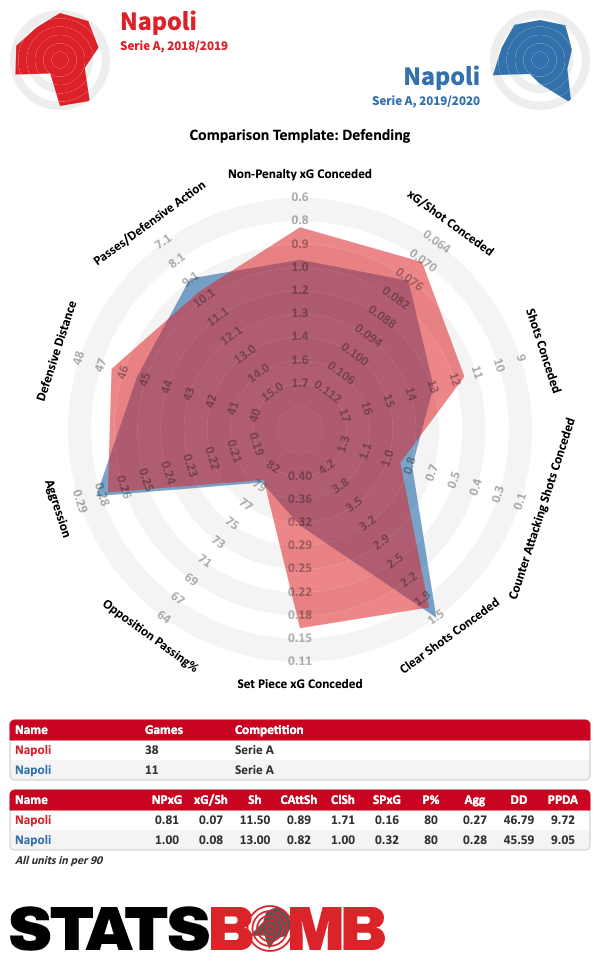
The 2019/20 version of the team also manages to keep opponent's shot quality low (0.077 xG per shot), but the increase in the number of shots conceded to the opponents has resulted in an increase of about 25% in the xG conceded per game (1.00) a value that puts them fourth in the league.
Judging from the radar, there could be a problem with set-pieces, too: they conceded twice on headers from dead ball situations plus Kalidou Koulibaly’s own goal against Juventus. Their 0.32 set piece xG conceded is the 4th worst value in the league but the set pieces shots sample is still too small to make a definitive judgment. It’s more likely that the slight worsening may have to do with the change of personnel and in general with a more aggressive defensive strategy compared to last season.
This summer, Napoli replaced Raul Albiol with Konstantinos Manolas, a less technical defender but much quicker and more athletic than the 34-year-old Spaniard, intending to provide Ancelotti with a center back that is less vulnerable in the open field and therefore better suited to support the team's high pressure.
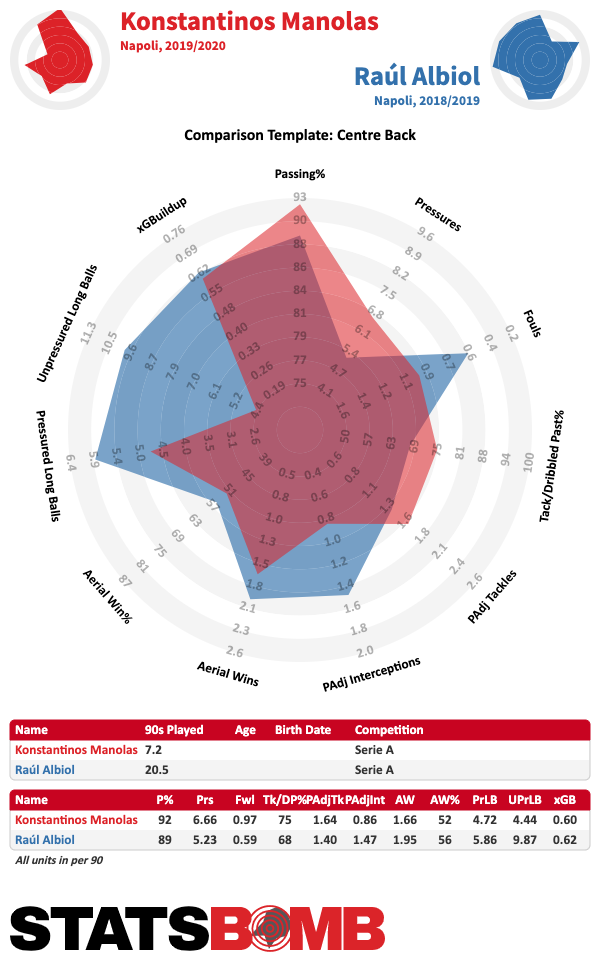
As you can see, the Greek defender is tougher to beat in individual duels than Albiol last season and is also more aggressive (more tackles, more pressures, and more fouls), while the Spaniard collected more interceptions. In possession, however, you notice the difference in the use of long balls, as Manolas is not exactly a superb ball-playing defender.
The other addition in defense was that of the Empoli’s rightback Giovanni di Lorenzo who imposed himself over Elseid Hysaj and Kevin Malcuit (whose season is already finished after a devastating knee injury). The Italian defender has not posted impressive numbers, but he is important as he is used to balance the system, since he plays as an added center back when Napoli attack, with Faouzi Ghoulam or Mario Rui pushing forward on the opposite side.
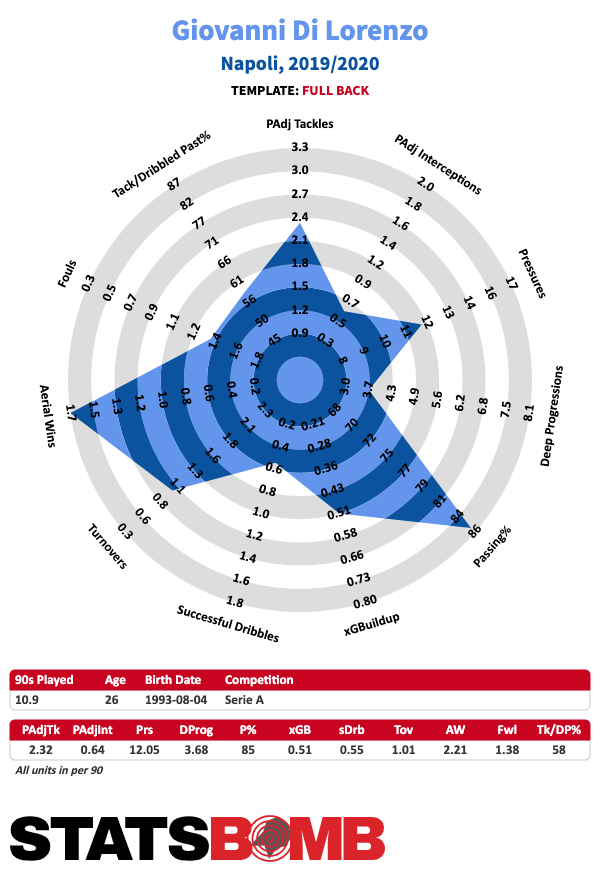
With this new personnel setup, Napoli has elevated their aggression coefficient, a metric that measures the proportion of passes that are aggressively pressed, to elite levels. Their 0.28 is the highest in Serie A along with that of Milan (!). Their reinvigorated pressing makes them the league leaders in pressures regains (34.18) to which they add 37.55 counterpressures. More pressing could mean more potential risks, but Napoli lowered both the number of counterattacking shots and clear shots conceded as compared to last season.
The main issue with this approach, which is more difficult to get out of the data, is that if Napoli's press is broken, the team inevitably becomes vulnerable. In fact, when the team presses it keeps the three-man defense, but when the opposing team manages to consolidate possession, the Azzurri shift to a four-man defense with the leftback who has to quickly rejoin the defensive line, with Di Lorenzo moving wider on the right.
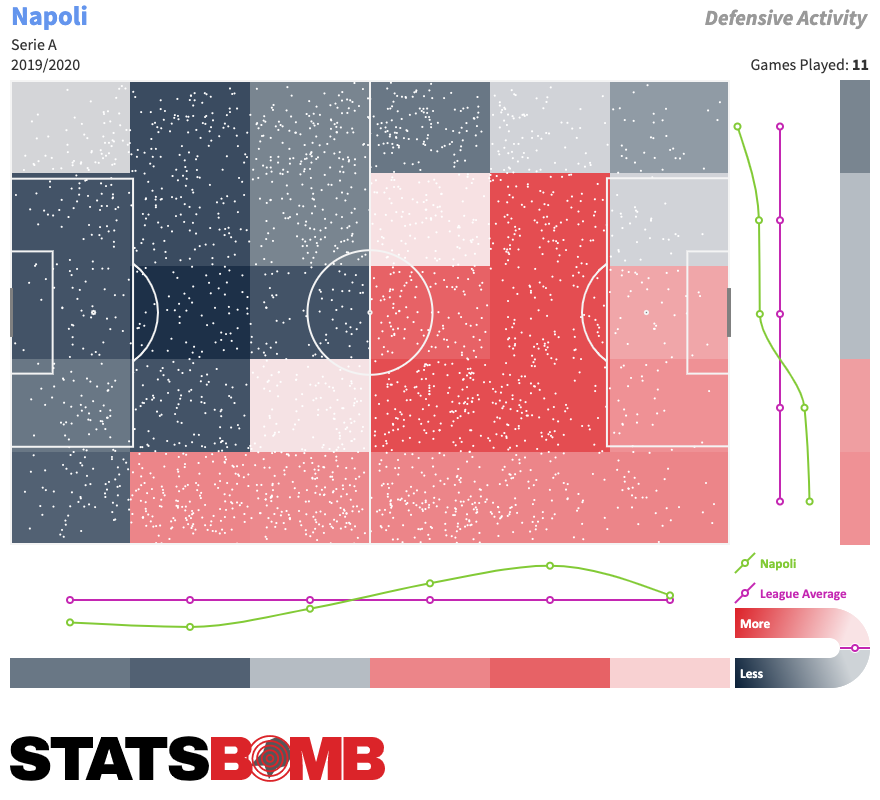
A clear asymmetry between the two sides emerges from the graph of Napoli's defensive activity: the left side is below league average for number of defensive actions, while the right side is above league average. This is a trend that was not observed last season, even though Ancelotti had already started to use this kind of setup, albeit with different players.
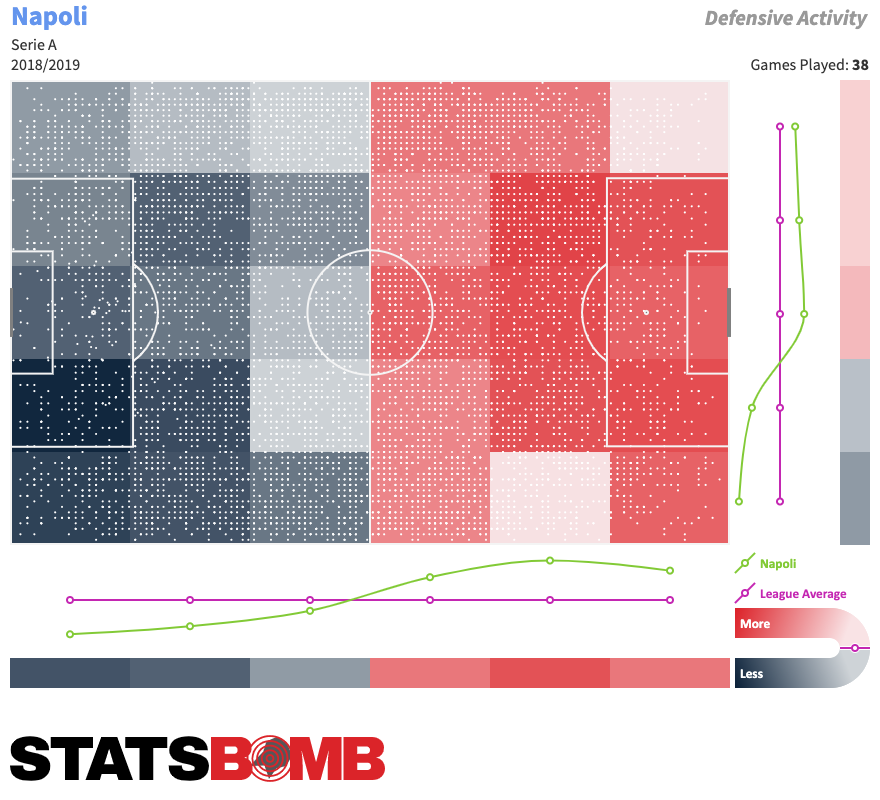
Due to this structure, Napoli are vulnerable against switches of play and often struggle to maintain vertical compactness. This can make them exposed against higher-level teams that can effectively execute their build-up play under pressure, like Roma. And, as we're about to get to, there are an increasing number of teams that are getting betting offensively, performing even better than Fonseca’s Roma side.
Attack
Napoli's underlying attacking numbers are similar to those of past seasons when they were the highest flying attack in the league. This season, they might have lost the throne in favor of goal-machine Atalanta, but they are maintaining exactly the same non-penalty xG average of 2018-19, 1.65. The thing is that other top-6 teams got better.
In comparison with last season Inter (1.62), Juventus (1.60), Lazio (1.57), and Roma (1.48) are producing much more from an offensive point of view. Ancelotti might have built a fluid offensive scheme which produces goals regardless of what players are playing which roles but the rest of the league seems to have caught up to them and Napoli have lost their edge in the number of xG generated.
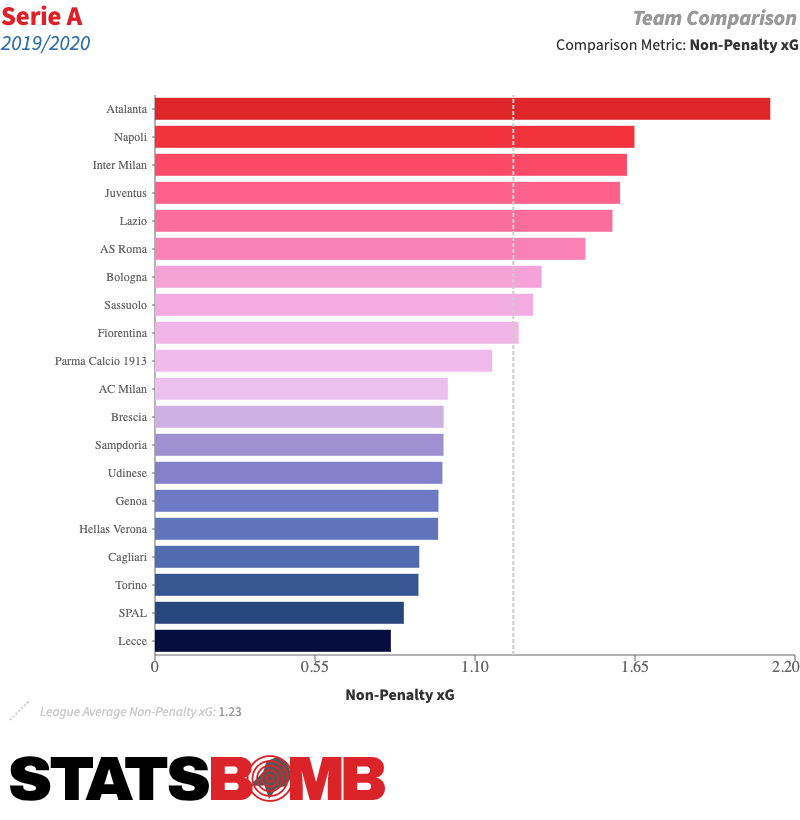
The Azzurri are no longer benefiting from the finishing that last year handed them a differential of almost eight extra goals against the xG generated. So far this season they've scored exactly the amount of goals they were expected to (19 out of 18,84 non-penalty xG), while last season, the ratio between non-penalty goals and non-penalty xG was 1.12.
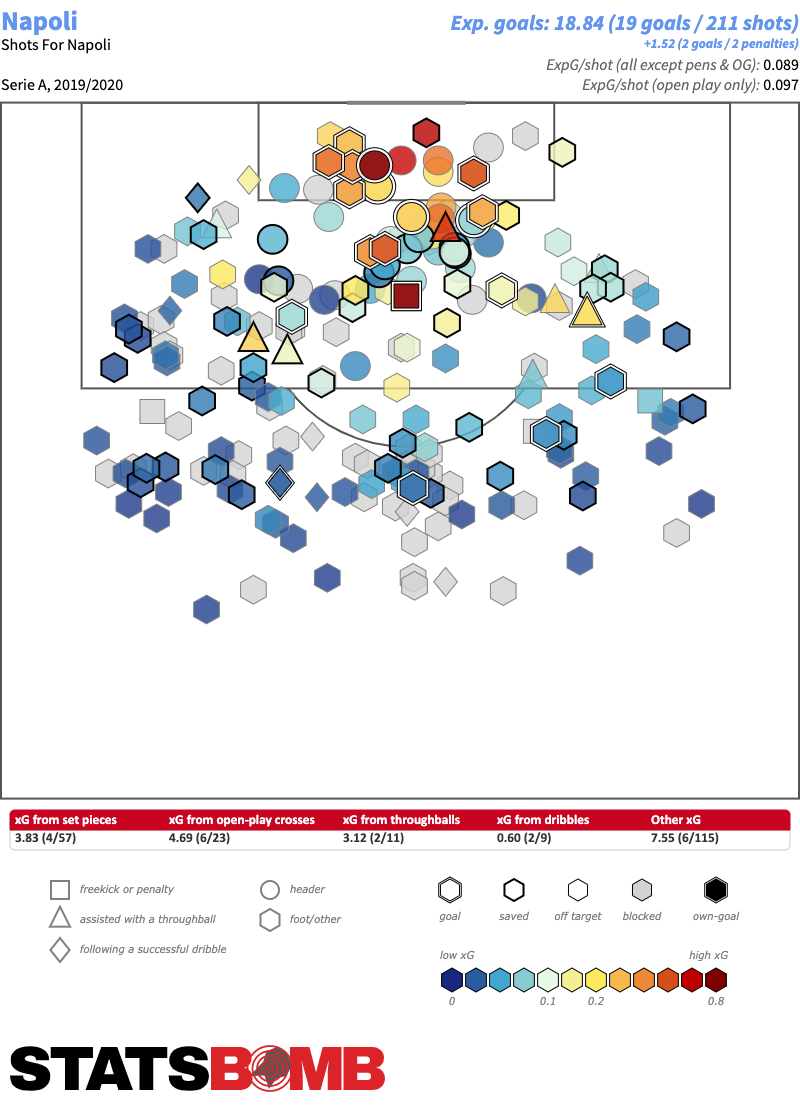
This figure also puts an end to questions about Napoli being unlucky so far: they are simply not maintaining last year's above expectations performance.
Napoli can therefore no longer rely solely on an offensive production far superior to the rest of Serie A, nor on above average finishing to play the role of Juventus' number one enemy. Napoli were the best team for xG difference last season, but so far Juventus and Atalanta have been in a different league in comparison to them, while Inter, Lazio and Roma are offering performances similar to those of Ancelotti’s team.
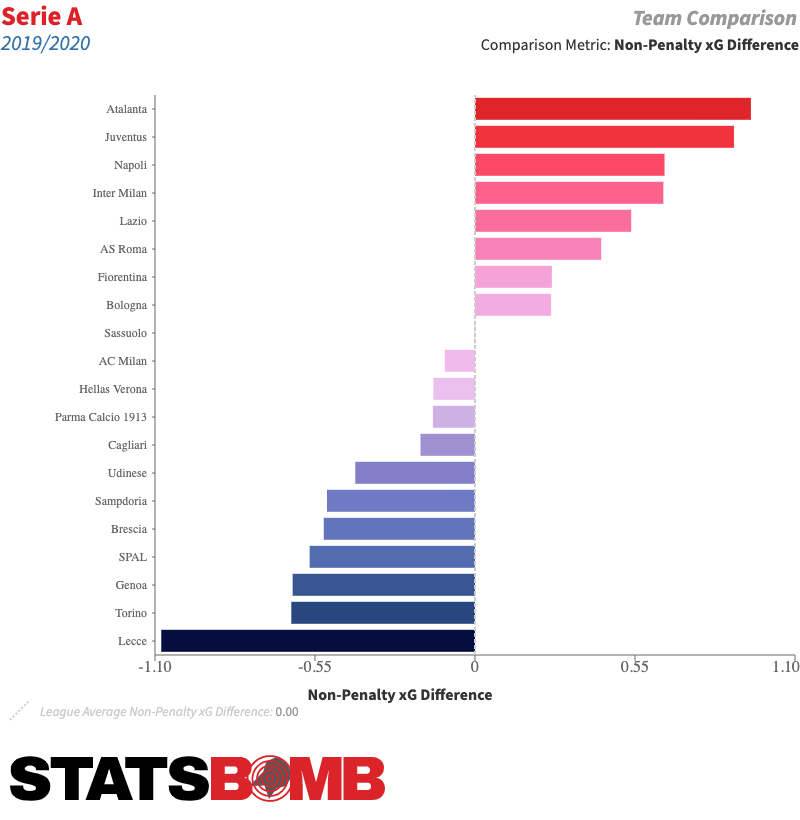
This is the key point: Napoli have been the only team able to compete with Juventus in recent seasons, but there has always been a bigger gap between the Bianconeri and the Azzurri than between the Azzurri and the rest of the league's top teams.
Other teams have improved, especially offensively, so much so as to challenge the position of Napoli as the second-best team in the league. To save their status, Ancelotti will have to restore the defensive phase to last year's levels without sacrificing offensive production or finding a way to make a further leap in their attack. Neither will be an easy goal to achieve.
Freiburg are the Bundesliga's little engine that could
After nine matchdays the Bundesliga is still very, very wacky. We now have a grand total of ten teams at the top of the table separated by a margin of only four points. So there has to be a true surprise team among those ten, right? Yes, very much so. While surprise leaders Borussia Mönchengladbach have all the makings of a legitimately good team, and Schalke 04’s revival under the guidance of David Wagner also seems to be real, we have teeny-tiny SC Freiburg in third place currently. Which is, by any measurement, shocking.
Let’s start off with the obligatory ‘raining on the parade’ from a statistical point of view. Because, yes, you can be a bit of Debbie Downer on Freiburg’s hot start.
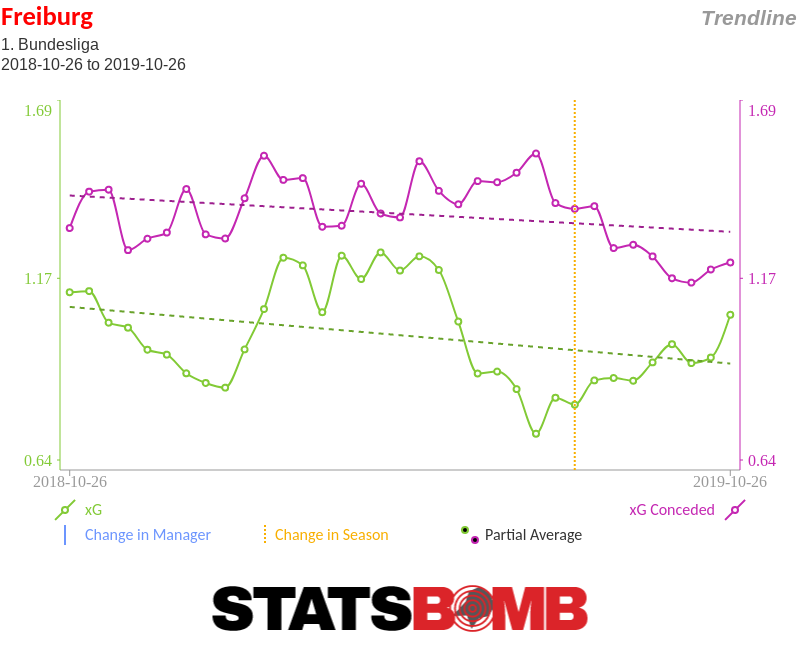
In attack, Freiburg have been absolutely lethal in regards to finishing off their bigger chances.
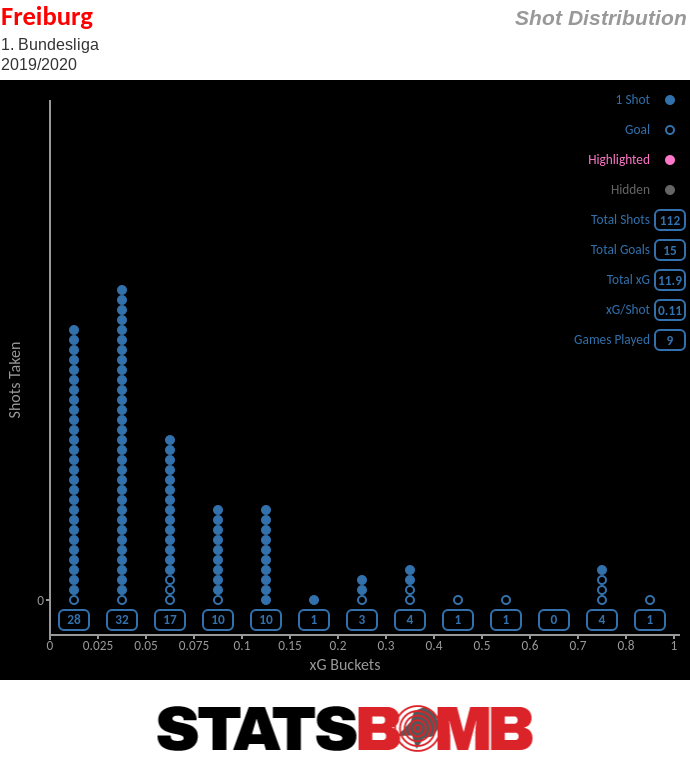
And, surprise-surprise, the opposition has been far less clinical from similar types of shots so far.
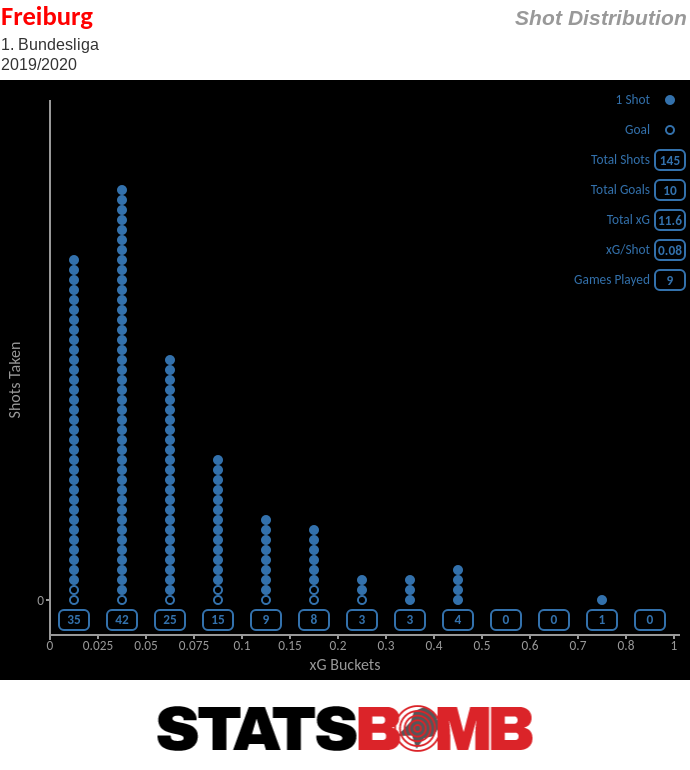
But as you can from the xG trendlines, Freiburg are definitely improving. Helped by this hot start, they have a legitimate chance of finishing in the top half of the table: if last season’s points total of the Bundesliga’s ninth team (Hoffenheim, 44 points) suffices this year, the local pride of southwest Baden Württemberg only needs 27 points from the remaining 25 games. A top-half finish would be a remarkable achievement for manager Christian Streich’s squad. Last season, only 1. FC Nürnberg had a smaller player payroll than Freiburg among the 18 Bundesliga teams - with the arrival of Union Berlin and Paderborn, the expectation is that Freiburg will rank in 16th place in that budget table this season. Which makes it all the more admirable that Freiburg could finish among the best half of the Bundesliga for the fourth time since 2010 this year. It seems that Streich and his boys truly are capable in the art of over-achieving. More than enough reasons to take a look at the standouts of the current squad.
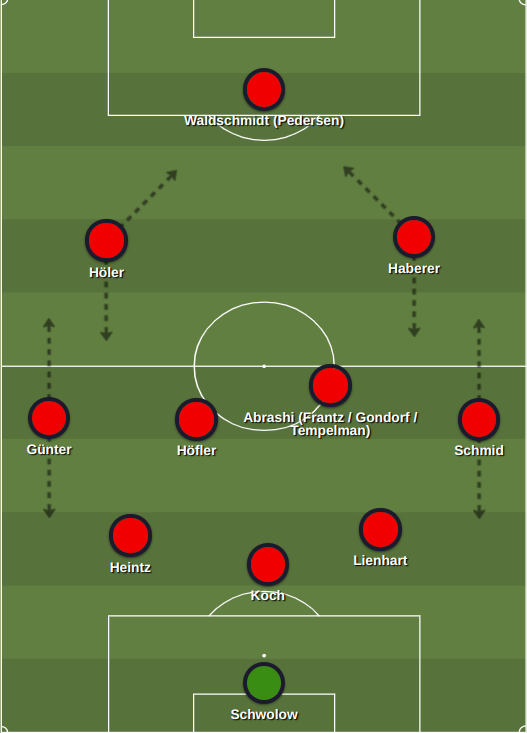
Defense
Although Freiburg do occasionally show nice bursts of an organised press and some feisty bits of gegenpressung, Streich’s squad mostly plays in a bend-but-don’t-break style. They defend in a 5-4-1 shape, with the two semi-wingers dropping back around the parts of the field where the opponent’s second midfield-option in the build-up occupies space. At the heart of the defense, we find a brand-new German international, Robin Koch. With the forced (and controversial) international retirement of Mats Hummels and Jérôme Boateng and the horrific injury for Niklas Süle, the 23 year-old really has a shot at playing time at the Euros next summer. Koch combines impressive size (6 foot 4) with adequate speed and agility, and impressive ball-playing skills.
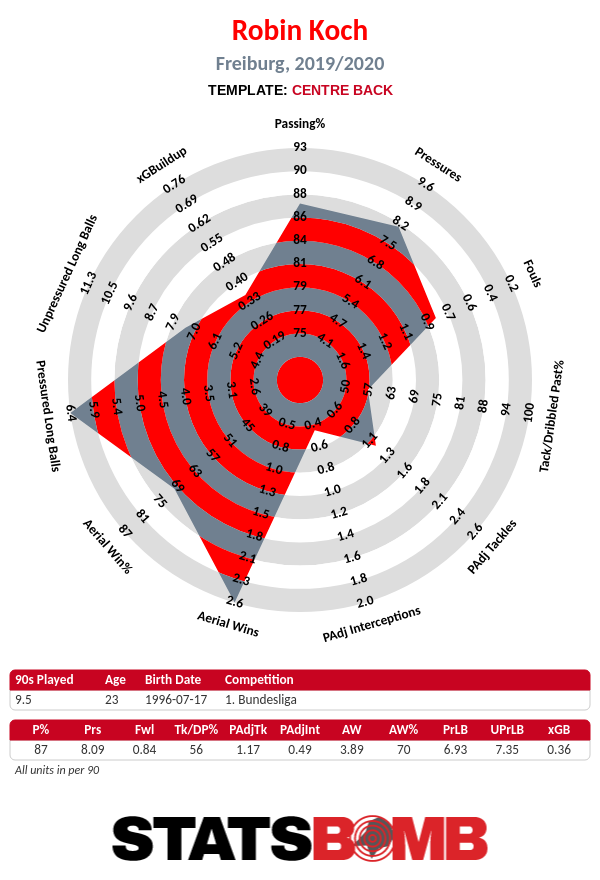
Considering the absolute dearth of capable, left-footed German centre backs, there’s also a reasonable chance that Koch’s partner on his left-hand side, Dominique Heintz, can make it to the final 23 at Die Mannschaft next summer. The 26-year old defender is less polished on the ball than Koch, but also quite big and physical (6 foot 3), and an excellent marker. The silent success of Heintz has been key for Freiburg’s hot start this season.
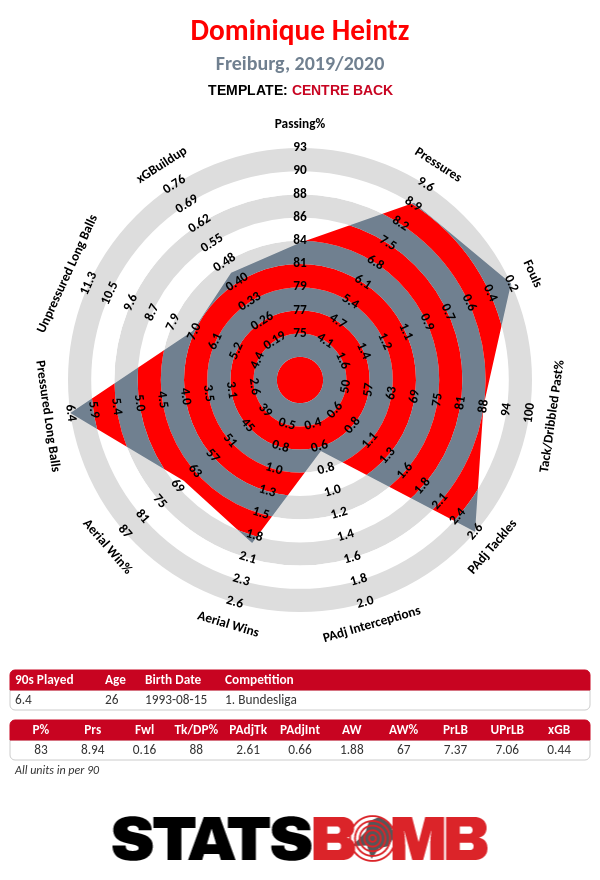
Midfield
Freiburg’s midfield four (in possession, they play from a 3-4-2-1 shape) is less stacked with individual talent than their back three. Veteran Nicolas Höfler, who is the best ball distributor in Freiburg’s direct passing game, gets accompanied by a ball-winning type in the heart of midfield, while a lot of attacking play goes through the oft-crossing wingbacks, Jonathan Schmid on the right, Christian Günter on the left. Positional discipline when switching from attacking to defending is key for this group: seeing that Freiburg’s play in possession requires a good amount of width, whilst their defending mostly happens from a compact shape, means that the transition to defense really is labour-heavy for this crew. As you can see from the defensive activity map below, Freiburg are not a pressing bunch.
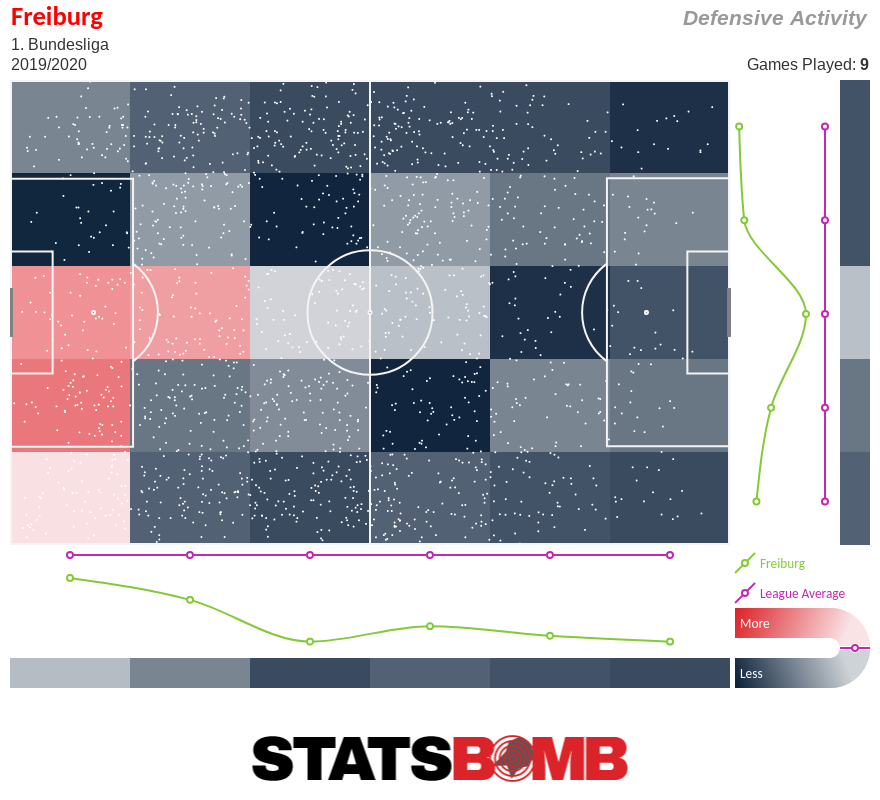
Attack
Centre back Koch is not the only young Freiburg player who recently made his international debut for Joachim Löw’s national team. Gian-Luca Waldschmidt was rewarded for an excellent summer and a decent start to the new Bundesliga season. Waldschmidt was crowned top scorer at the European Championships for u21’s this summer, where Germany finished as runners-up to a dominant Spanish side; the young lefty scored a whopping total of seven goals in the tournament’s first four games, including an absolute rocket of a long shot (seriously, YouTube it). While Waldschmidt clearly is talented - he accompanies his splendid shot-technique with some nice vision and agility - and has scored five goals in his first eight official games of this season, the 23 year-old doesn’t seem to be playing in an ideal role in Streich’s effective, direct system. That shot map is a giant yikes!
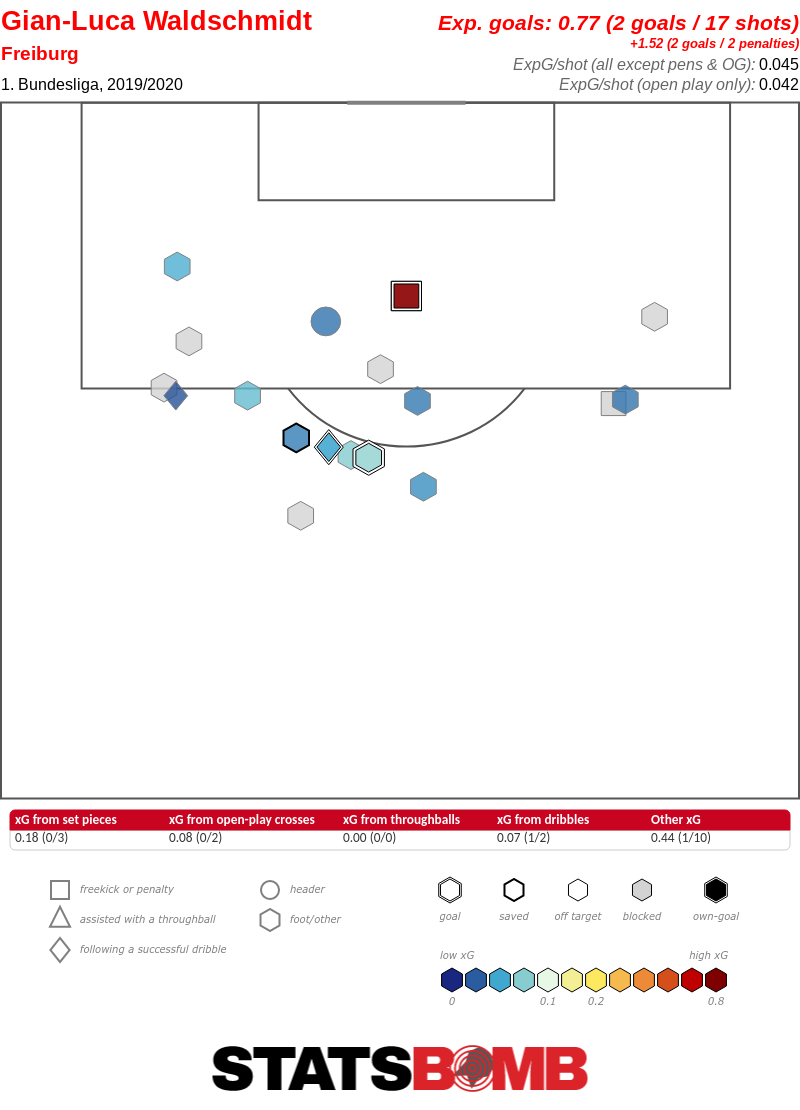
Waldschmidt has been getting the majority of his minutes as a central striker in Freiburg’s 3-4-2-1, where he shares minutes with super-sub Nils Pedersen. But the youngster’s shot selection clearly leaves a lot to be desired from an out-and-out striker. In many ways, Waldschmidt’s game has a lot of similarities to a former Freiburg standout, Max Kruse. Just like Kruse (a lefty with a cannon of a shot as well), Waldschmidt seems to have the skillset to become a star player as a semi-striker - not a classical number 9, but also more of a poacher than a classical number 10.
But there currently seems to be no such role to be carved out for Waldschmidt. Because the current ‘semi-wingers’ epitomize Streich’s no-nonsense, heavy-workload playing style that makes Freiburg supersede their financial means. On the right, all-rounder Janik Haberer has been very useful with his somewhat insane workrate, and high football-IQ runs. But the true ‘grit’-standout of Freiburg’s season so far has been Lucas Höler.
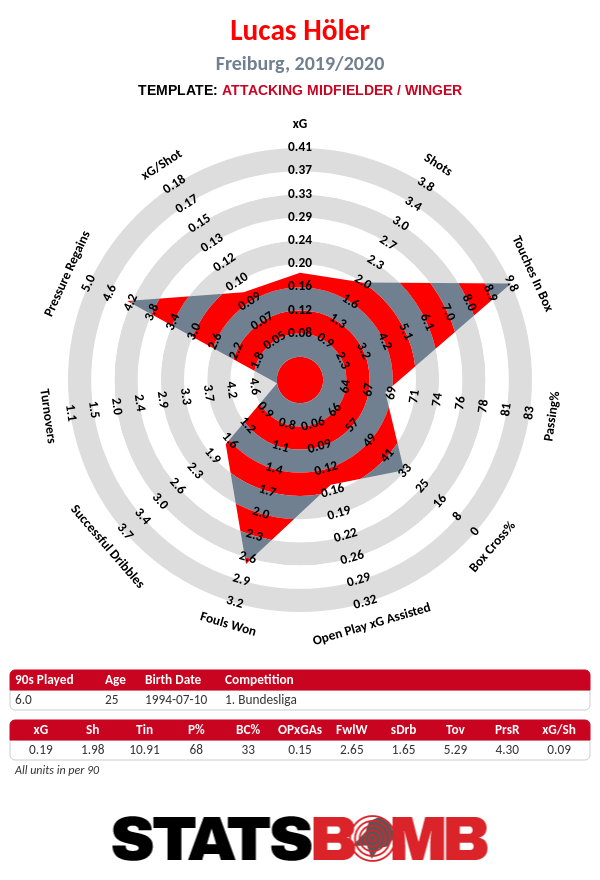
On paper, the 25-year old is a striker. He also looks like a striker - albeit not a super deadly one, having scored 45 goals in 151 lower-league appearances before joining Freiburg in 2018. He even wears the number 9 on the back of his jersey. But Streich has molded Höler into a gloriously useful supporting player in one of the half-winger-half-striker roles in his formation. As a pure attacking talent, Höler would never stand out in the Bundesliga. But at Freiburg, his workrate and game intelligence have made him into one of the most important players in the squad, and a fitting symbol for this small team’s consistent success.
Five games into the WSL and there's fun wherever you look
The Women’s Super League is five games in and we have a tasty, tasty title race on our hands.
‘The Big Three’ (as I’ve taken to calling them) of 2017-18 champions Chelsea, 2018-19 champions Arsenal, and 2016* champions Manchester City are separated by just one point at the top of the table.
*Before 2017-18, the WSL was played on a summer rather than winter season schedule
But England’s top tier of women’s football is not a three-team league and there’s plenty going on up and down it. Here are the broad headline trends before we take a proper look at the table.
- The Big Three remain the Big Three for now, but Manchester United may be joining them soon
- There’s a definite midtable group: by eye and by stat, West Ham and Everton are in there, as are Reading and Tottenham, although things get more fluid towards the bottom of this group and the top of the third group…
- …this group is the bottom four in the current league table, who probably all deserve to be there. Bristol City, despite their sixth-place finish in 2018-19, appear to be really struggling looking at the stats.
Here’s the table at the moment (NB: Reading and Birmingham City have had a match postponed):
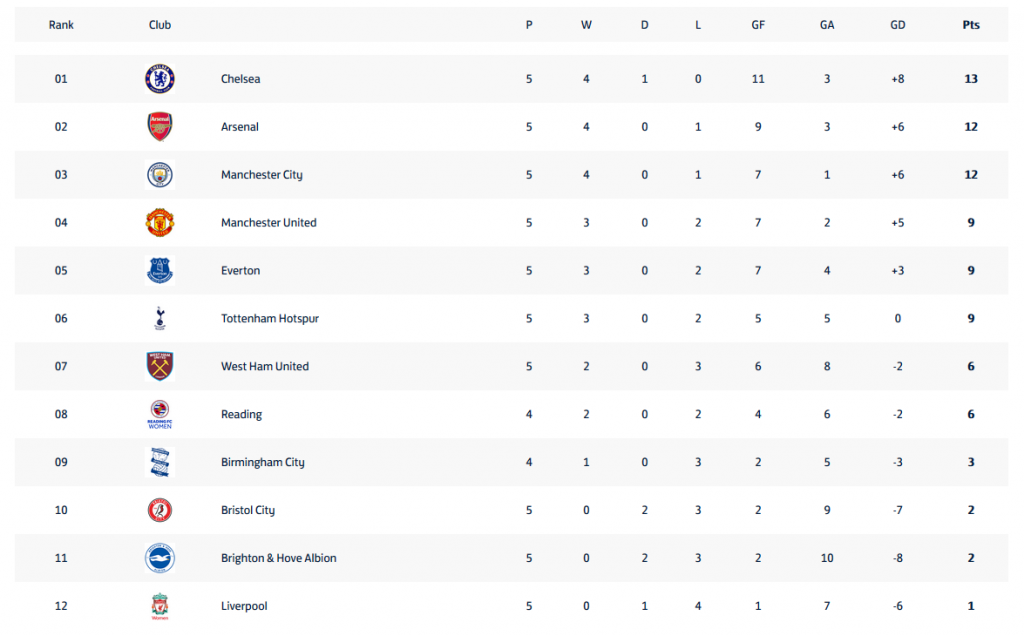
And we’ve also got the teams sorted by StatsBomb’s expected goals per game (a measure of chance quality, specifically with penalties stripped out as spot-kicks are extremely high value but can happen pretty randomly). Fixture schedule or a one-off tonking can skew the numbers a bit, but here we go:
While the Big Three exists in terms of points and overall quality, there are some interesting quirks in how they play. Arsenal women are doing what Arsène Wenger would have been proud of the men doing back in the day: possession, and plenty of it. Joe Montemurro’s team average the most spells of possession per game that contain 10 or more passes (22.0), more than double the third-highest team on the list (Chelsea, with 10.6).
Manchester City are the team sandwiched between them, but though City are pass-happy with the ball, they’re a slightly unexpected mix defensively. They’ll certainly press you if you get the ball in your own defensive third – only 20% of the possessions starting there against City have lasted long enough to string five or more passes together, giving City the second press-iest rate in the league.
However, if you manage to make it out of the press alive, they seem to relent. They allow 8.6 possession sequences with 10+ passes per game, which is the second-highest amount in the league. It’s even more than the lowly Bristol City, whose opponents only manage an average of 7.8. City are, generally, surprisingly easy to pass through for a team challenging for the title, and their latest outing, a crunch match against Arsenal, was stark in terms of the difference between the two sides on the day.
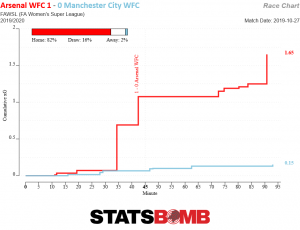
That win was a big three points for Montemurro’s Gunners, as had they lost, they’d have been six points behind City. A defeat to Chelsea in mid-October provoked wonders about the team’s ability to defend last season’s title and ire from Montemurro:
A first for me today- I’ve never seen Joe Montemurro angry before, but he was today. I asked him if the plan was to play on the counter in the second half. ‘No, we just played badly and couldn’t keep the ball.’
— Tim Stillman (@Stillberto) October 13, 2019
The Australian manager has noted in the past how he prefers a small squad and, unlike the previous league campaign, he’s actually having to use it. Arsenal averaged the second-fewest changes to their starting XI from match-to-match in the WSL last season (1.3) but so far in 2019/20 they’ve averaged the most (2.25). The number of changes isn’t necessarily meaningful in and of itself, but that large a change certainly seems indicative of a team who had things going their way last season in a way that they aren’t quite this time around.
That’s worrisome because Arsenal, and City for that matter, will have to be the the top of their game to keep pace with Chelsea this season. The Blues have the strongest numbers of the trio and no Champions League to contend with (although neither, after this week, do City). They're built on a solid defensive foundation and have a great cast of attacking players to contribute to attack: Fran Kirby, Erin Cuthbert, Ji So-yun, striker Bethany England, and new signing Guro Reiten give a great strength in depth.
And last season's campaign, finishing third in the league and 12 points off winners Arsenal, will surely be a source of inspiration for the Blues. Being that far off first in a title defence year must have stung, not helped by a start to the season of three goalless draws but an expected goals balance of 4.67 to 1.49. This season they've had no such stumbles, and it's set the title race up nicely.
In terms of the midtable chasers we can talk about Manchester United another time – they will not be short of column inches this season – but Everton and West Ham look like they’re worth paying attention to. The Hammers are a solidly good side who turn up against the big guns and are led by Matt Beard, twice-winner of the WSL as manager of Liverpool in 2013 and 2014 (back before they were neglected into becoming relegation-battlers…). They have 16 players born outside the UK, the highest number in the league and a figure I’ve taken from a great article by Kieran Theivam on The Athletic about just how a WSL side deals with that (although one might wonder whether player settling services might be something that a club like West Ham could share between men’s and women’s sides). Everton, meanwhile, have a much more homegrown squad, including 21-year-old September Player of the Month Chloe Kelly, who currently leads the league on four goals in five games. Sure, she’s overperforming her expected goals, and that expected goals figure is inflated by a single near-open-goal shot against Reading, but she’s fun to watch.
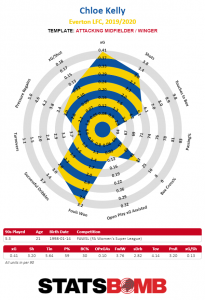
Speaking of fun to watch, Manchester City’s Janine Beckie has hit the ground running after spending the majority of last season out injured. The Canadian is currently averaging 2.53 successful dribbles per game and the highest xG per 90 in the league (0.62). The vast majority of her expected goals comes after receiving through-balls, a major chunk of the rest comes immediately after a dribble, and as much as I would prefer to big up players outside the major clubs, Beckie’s someone you’ll want to tune in for (even if she’s yet to score in the league).
But in terms of pure influence for their team, few could rival Reading’s Fara Williams. The 170-capped England legend set up all three goals in the recent win over Everton and has the sixth-highest expected goals contribution per game in the league (0.64; 0.22 expected goals plus 0.42 expected goals assisted).
The 34-year-old is helping to power a team who look like they’re trying to set-piece their way to victories. So far, they’re first in the league for expected goals per game created from dead-ball situations and only seventh from open-play. Granted, their set-piece defence is the second-worst in the league at this stage, but Williams’ delivery, and all-round quality and experience, is something that most teams would be very envious to have.
One of which would be Liverpool, and given that I mentioned earlier that they were ‘neglected into becoming relegation-battlers’, I should elaborate on their situation (particularly given the success and positive press that the men’s team, and club as a whole as an extension, are receiving at the moment).
Right at the start of last season, manager Neil Redfearn resigned, just three months into the job after previous manager Scott Rogers left. The intervening months had seen many players change one red shirt for another and join the then-newly formed Manchester United, while Redfearn’s sole game in charge was a 5-0 defeat to Arsenal. That the Gunners eventually went on to win the title makes that scoreline look a little less embarrassing in hindsight, but there’s no positive way to spin the rumours that the impromptu departure was down to dissatisfaction at how the women’s team was being run.
Since last season, there has been a smidgen of a recovery. There is, at least, more stability in the coaching set-up and a relatively star player in Melissa Lawley, who’s arrived from Manchester City. Lawley is doing what she can – averaging over three dribbles and nearly six deep progressions (passing or carrying the ball into the final third) per game, as well as the longest average carry distance in the league – but she can only do so much. No-one in the squad is contributing more than 0.15 non-penalty expected goals per 90. For reference, Arsenal centre-back Leah Williamson is averaging 0.12, and Liverpool only have two players beating that.
It’s certainly going to be a tough old season for the Reds, who are not only bottom of the league on one point but are also the only team yet to play one of the Big Three. Their next trio of league matches (starting on 17 November after an international break) are a Merseyside Derby at Anfield (that, on form, they look likely to lose); a trip to Arsenal; and a trip to Manchester City. They then have a home game against West Ham before hosting Chelsea, so it isn’t beyond the realms of possibility for them to go into Christmas still without a win.
But let’s end this on a happier note. Now-Manchester United winger Leah Galton took a break from football in 2018 after having fallen out of love with football. She’s now back, is ripping up the league on United’s left, and made the news this week for having turned down a call-up to the England squad, though not for acrimonious reasons.
Here’s United manager Casey Stoney: "Playing for your national team is something that Leah and other players dream of, however I am strong on a player’s needs coming first and seeing them as human beings. Leah is just starting to fall back in love with the game again and I fully support her in not being ready for that next step yet.”
Manchester United took far, far too long to re-establish their women’s team after disbanding it in 2005, but it’s nice to see them taking good decisions since they’ve joined the party.
